DashClicks Blog
The industry's top experts offer their best advice, research, how-tos, and insights—all in the name of helping you level-up your business and online marketing skills.
Join Us!

From Stretched Thin to Scalable: Profitably Grow with White Label SEO
Every day, digital agencies must deal with an increasing number of clients, shorter deadlines, and higher demands than ever before. Running an agency today feels less like steady growth and more like sprinting on a treadmill—you’re moving fast, but not really scaling.
What's wrong? SEO isn't something you can just leave alone. It requires constant optimization, deep technical know-how, and fresh strategies to keep up with Google’s near-constant updates (the search giant made over 4,000 changes to its algorithm in 2023 alone). When you do everything in-house, your teams will likely be exhausted, yield mixed results, and growth will stagnate.
That problem can be turned into a growth engine with white label SEO services, which lets companies provide outstanding SEO without having to hire more staff or use up all of their own resources.
What Exactly Is White Label SEO?
When you get white label SEO, an outside team of SEO experts provides a service that looks like it came from your own business. Your clients don't know that you work with another provider because they only see you as the source for strategy, execution, and reports. Behind the scenes, a specialized partner is powering delivery with tested frameworks, tools, and expertise.
White Label vs. Outsourcing
Your brand's integrity may be compromised when outsourcing because your name is commonly associated with the provider's. With white label SEO services, your agency stays in the spotlight, and your clients experience seamless delivery—from proposals to reports—while you retain full control of the client relationship. Think of it as having a silent partner who strengthens your agency without stepping into the spotlight.
Common Misconceptions
Working with a white label partner can increase your service capacity even with an established agency. Some agency owners hesitate, believing that:
- “Quality control is out of your hands.” Not true. With the right partner, you can set benchmarks, track progress, and hold delivery teams accountable.
- “White label SEO is only for startups.” Even established agencies use it to expand capacity. In fact, 41% of agencies cite resource limitations as their biggest growth barrier. White label SEO directly addresses this.
Done right, it’s not about losing control—it’s about gaining scalability without compromise.
Why Agencies Can Profitably Scale With White Label SEO?
Getting together with a white label SEO provider can help you grow without spending excessive funds.
- You can add more services immediately without having to pay for and risk hiring a full-time SEO team.
- Keep the profit margins healthy while reducing operational costs.
- You can get advanced help with things like technical SEO and building links without buying expensive tools.
- Level the playing field against larger businesses by providing the same range and level of services.
Think of it as similar to how contact centers use an auto call dialer or automation tools to maximize efficiency—white label SEO gives agencies that same operational edge.
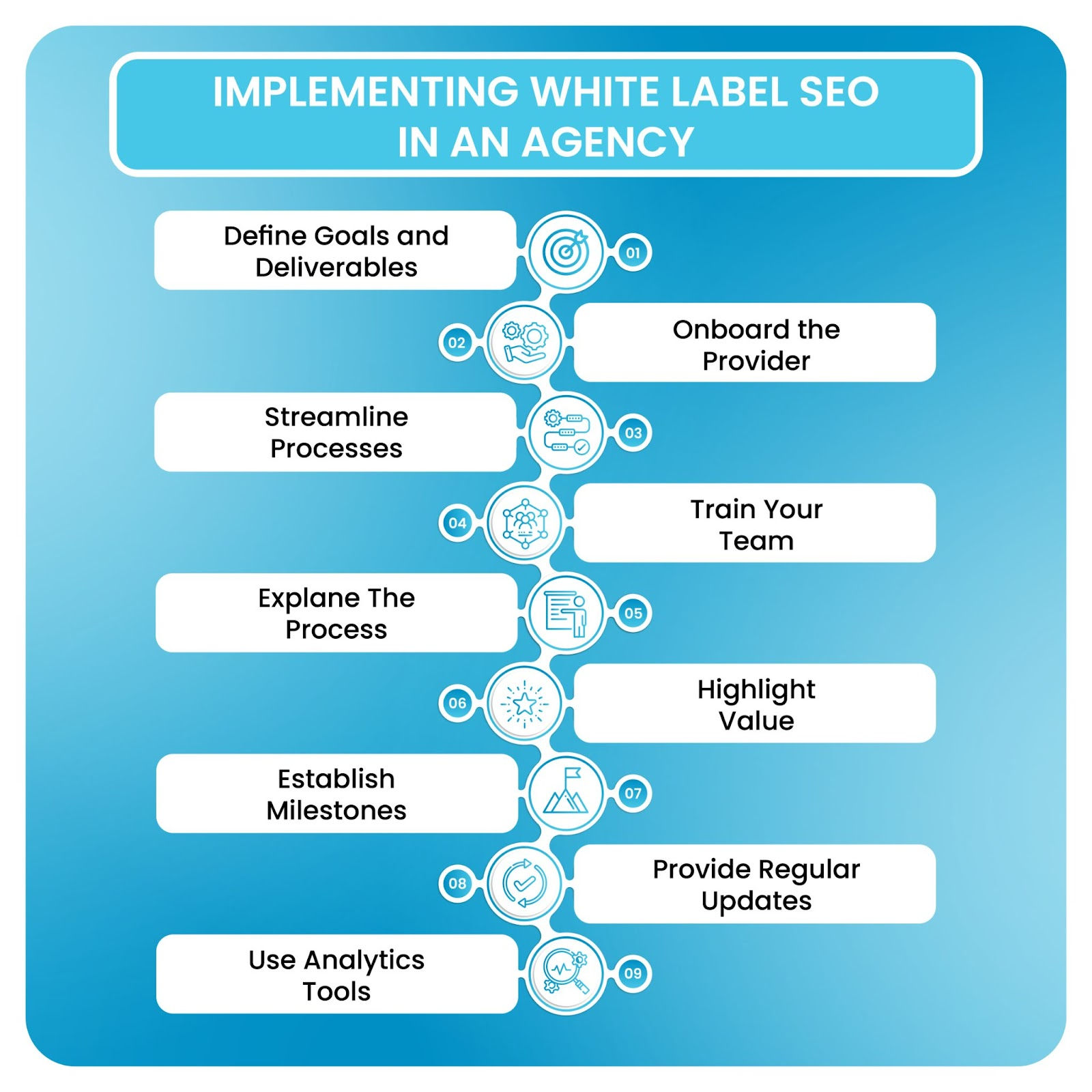
Additional Benefits Of White Label SEO
Although it's clear that white label SEO saves money and offers expertise, there are other benefits that agencies often miss.
- Shorter Turnaround Times: A partner with a lot of experience can help you finish a project much faster. This speed can help you get projects done quickly and make clients happy.
- Consistent Quality: White label providers with a good reputation use reliable techniques to make sure that every campaign meets high standards. Effective campaign planning helps maintain consistency and achieve better outcomes.
- Scalable Workflows: With no hiring and firing, you can handle seasonal increases in demand.
- Increased Client Retention: Customers won't go to competitors for SEO if you offer a complete marketing package. According to Invesp, it’s 5x cheaper to retain a client than acquire a new one—and white label SEO makes retention easier.
Beyond Cost Savings: The Real Value of White Label SEO
For many agencies, the first attraction of white label SEO is its cost efficiency. After all, avoiding the expense of hiring, training, and managing a full in-house SEO team is an obvious win. But the true value goes much deeper.
From Survival Mode to Growth Mode
Agencies that manage SEO in-house often operate in survival mode—constantly reacting to algorithm updates, client demands, and resource shortages. White label SEO flips the equation by creating space for growth. Instead of fighting fires, your team can focus on acquiring new clients, developing stronger relationships, and building out complementary services like PPC or social media marketing.
Turning Fixed Costs Into Scalable Investments
Hiring in-house staff is risky—payroll, benefits, and training are fixed costs whether demand is high or low. With white label SEO agency, you turn those fixed costs into flexible, scalable investments. You only pay for what you need, when you need it, which means you can take on more clients without worrying about long-term overhead. This financial agility allows your agency to scale faster and with less risk.
White Label SEO and Client Perception
Scaling your agency isn’t just about delivering SEO—it’s about how clients perceive the value you provide. White label SEO helps strengthen your client relationships in ways that go beyond just rankings and reports.
How Branded Reporting Builds Trust?
White label providers often give agencies the ability to deliver fully branded reports and dashboards. When clients receive professional, agency-branded insights, it reinforces your authority and professionalism. To them, it looks like you have an entire SEO department running behind the scenes, which builds confidence in your capabilities.
Why Clients Care More About Results Than Who Does the Work?
Clients rarely ask who is executing the SEO—they care about what it achieves. As long as your agency delivers consistent, measurable results, clients remain loyal. White label SEO ensures that delivery stays reliable, while you remain the face of strategy, communication, and success. This combination strengthens client retention and positions your agency as a trusted, full-service partner.
How to Pick the Best White Label SEO Company?
Not every service provider is the same. If you pick the wrong one, you could lose money, time, or even your good reputation. That's why you should think things through before you decide. Here’s what to look for:
- Choose service providers who have proven track records of success. To see examples of their work, ask for case studies and client references.
- You should be able to send branded reports to clients from your service provider without having to make any changes to them. In this way, things stay pleasant and straightforward.
- Select a partner that can use the tools and methods you already have. More changes to your workflow are not better. Don’t overlook the importance of clean, enriched data feeding into those workflows Waterfall Enrichment technology can help ensure your CRM and client reporting stay accurate, so you can scale without running into gaps or inconsistencies.
- It's important to get updates quickly and clearly. Your partner should answer quickly and always let you know what's going on.
- Stay away from service providers that say they can rank you instantly or use questionable ways to build links. Always pick SEO strategies that are honest and will last.
How to Avoid Common Mistakes?
To get the most out of white label SEO, avoid these mistakes.
- The cheapest option often costs more in lost customers when price is the only factor in a decision.
- If you don't align your communication, clients can get frustrated by mismatched turnaround times or updates that aren't clear.
- As soon as you start, do a pilot project to see if it works for you before making a long-term commitment.
A reliable partner should feel like an extension of your team, not a wildcard.

How to Easily Integrate White Label SEO Into Your Agency?
Clients won't even notice that someone else is doing the work if the integration goes smoothly. They'll only see better results. Before committing to a bigger project, try it out on one or two client projects first. This helps you find and fix any problems with the process quickly.
All of your reports, proposals, and emails to clients should use the same style as your brand, so the whole process feels like it happened in-house. Your sales team needs to be trained so they can confidently offer SEO services as part of what you do. To keep things running effectively, make sure you and your partner agree on clear ways to share tasks, updates, and feedback.
What's Next for White Label SEO?
With the development of AI-powered search and voice assistants, the need for SEO is only going to grow. The best agencies for growth will be those that can provide strong SEO without increasing prices. White label partnerships are getting smarter, with better automation, reporting, and strategies that are made to fit the needs of each client.
The agencies that thrive will be those who adapt quickly—something white label partners are uniquely positioned for because they invest in tools, R&D, and process improvements across hundreds of campaigns.
Using White Label SEO to Protect Your Agency for the Future
To stay ahead in a field where search algorithms change almost every month, you need to get the newest tools, insights, and best practices right away. White label SEO companies often spend a lot of money on training, premium tools, and research that smaller agencies might not be able to afford on their own.
This means:
- Faster adaptation to algorithm updates.
- Stronger, future-proof campaigns.
- Consistent client trust built on measurable results.
By consistently getting results that can be measured, you make your agency look like a trusted full-service partner instead of just a vendor. This makes sure that clients stay with you for a long time and recommend you to others.
Why Choose DashClicks’ White Label SEO Services?
Scaling an agency often comes with growing pains—hiring, training, and managing an in-house SEO team can drain resources and slow down growth. DashClicks’ White Label SEO services remove that burden by giving agencies a complete, ready-to-use SEO solution under their own brand.
With DashClicks, you get a full suite of services, including in-depth keyword research, on-page and technical SEO, content optimization, and high-quality link building. Every campaign is executed by SEO specialists who stay on top of Google’s latest algorithm updates, ensuring your clients always receive strategies built for long-term success.
What makes DashClicks unique is the technology behind it. Agencies get access to a powerful white-labeled dashboard where they can track progress, manage campaigns, and send branded reports directly to clients—no extra effort required. This not only saves time but also builds client trust and positions your agency as a full-service authority.
Whether you’re looking to expand your service offerings, retain more clients, or improve profitability, DashClicks gives you the systems, expertise, and scalability to grow without limits—while keeping your brand at the center of the client experience.
Wrapping It Up
White label SEO isn’t a shortcut—it’s a smart, scalable growth strategy. It allows agencies to:
- Expand services instantly.
- Protect brand credibility.
- Deliver consistent, high-quality results.
- Retain clients longer while keeping margins healthy.
Pairing SEO with white label GMB management and tools like local rank tracker makes your offer even stronger, especially in competitive local markets.
In a landscape where the global SEO industry is projected to surpass $134 billion by 2030 (Grand View Research), agencies that embrace white label SEO now position themselves for sustainable, profitable growth.
The right white label SEO partner doesn’t just fill gaps—they give you the edge to scale confidently and focus on what matters most: driving your agency’s revenue.


The Role of Scenario Planning Software in Project Portfolio Management
With the rise of AI solutions for businesses, scenario planning and project management forecasting software have become vital in optimizing processes and resources. Work that was done manually before and wasted a lot of resources can now be simplified by leveraging AI tools that act based on historical data, predicting potential outcomes, and best strategies. They simulate different scenarios, allowing businesses to make considered decisions and effectively deal with uncertainty.
Importance of Project Management Forecasting Software
Traditional planning often relies on manual spreadsheets and reports, where the risks of human factor mistakes are extremely high. We can highlight common challenges that companies face without implementing project management forecasting software:
- Difficulties in prioritizing tasks and projects.
- Balancing limited resources while meeting the demands.
- Difficulties in predicting and mitigating risks and changes.
- Difficulties while analyzing data and making informed decisions.
- Making decisions without data can cause conflicts.
But their main problem is a lack of real-time insights. They give a full picture of processes and problems that happen during project execution. Forecasting in project management is an essential process that brings several advantages to managers, executives, and other experts.
- It allows predicting risks in advance and effectively managing them.
- It provides control over costs and deadlines, ensuring that the project will be delivered on time within budget.
- It ensures better coordination of projects and resources across the portfolio.
- It saves experts’ time, allowing them to focus on the company’s strategy and growth.
- It also saves costs, giving the opportunity to invest in more important initiatives.
- It allows predicting delivery dates based on current progress and resource availability.
- By detecting bottlenecks early, it enhances quick adjusting of resources to these changes.
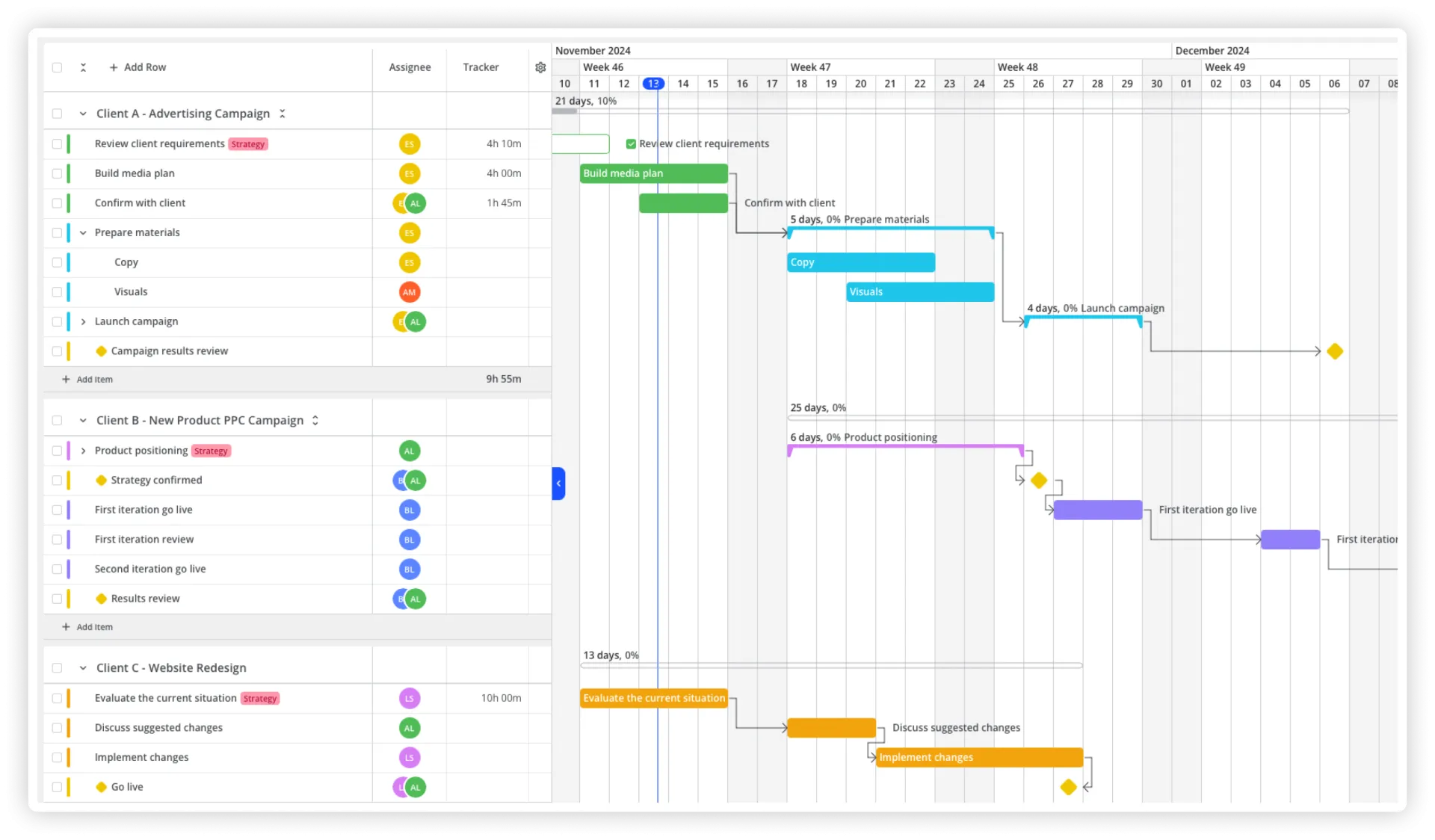
Image Source: Teamhood
How Scenario Planning Software Elevates Decision-Making?
In a rapidly changing business environment, decision-making cannot depend on intuition or static reports alone. Scenario planning software gives leaders the power to model different “what-if” situations before committing to a strategy.
For instance, managers can simulate how a sudden resource shortage, a shift in client demand, or a delayed milestone would affect multiple projects simultaneously. The ability to run simulations across time horizons and resource constraints helps organizations prepare contingency plans, not react to crises after they occur.
This kind of proactive management enables companies to:
- Visualize how various decisions influence timelines and budgets.
- Identify the most resilient strategies under uncertainty.
- Maintain agility by pivoting to the most favorable scenario.
- Reduce financial and operational risks across portfolios.
In short, scenario planning transforms project portfolio management from reactive problem-solving into predictive strategy design.
5 Features of Project Management Forecasting Software You Need to Try
Modern project management forecasting software tools have critical capabilities that make them irreplaceable for project prioritization and risk management. The most vital features are the following:
- What-if scenario planning allows testing different scenarios in an independent environment before implementing real changes in projects.
- Workload forecasting shows the future workload of resources, allowing detection of overload in advance and reallocation of resources if needed.
- Advanced predictive analysis is essential for project and task prioritization that helps to predict bottlenecks and overload, making processes more efficient for organizations and delivering projects on time.
- AI agent project managers are innovative tools but already have a strong position in the market. It is artificial intelligence software that acts like a smart project manager with the ability to detect bottlenecks and alert about them, send reminders about some routine tasks, and help real managers and executives with proper resource allocation.
- Automatic schedule adjusting replans due dates to deliver projects with minimum harm if delays because of resource overload or limited capacity are detected.
Experts use these tools to gain real-time information important to improve project and resource planning. Maximum value of these features is given to multi-project environments where it is vital to stay on track with all processes across the project portfolio.
Benefits of Integrating AI into Project Forecasting
Artificial Intelligence is reshaping how organizations predict, plan, and allocate resources. When integrated into project forecasting, AI acts as an analytical engine that learns from historical data, identifies recurring patterns, and anticipates potential outcomes.
Key benefits include:
- Enhanced Accuracy: AI-driven predictions reduce human error by using vast data sets to identify trends that manual methods overlook.
- Proactive Risk Detection: Machine learning models flag potential bottlenecks and performance issues early, allowing preventive action.
- Smarter Resource Allocation: AI algorithms balance workloads and optimize capacity across multiple projects simultaneously.
- Faster Decision-Making: AI eliminates guesswork by providing clear recommendations backed by data.
By automating repetitive processes, AI frees up managers to focus on innovation and leadership rather than data crunching — helping organizations become more strategic and less reactive.
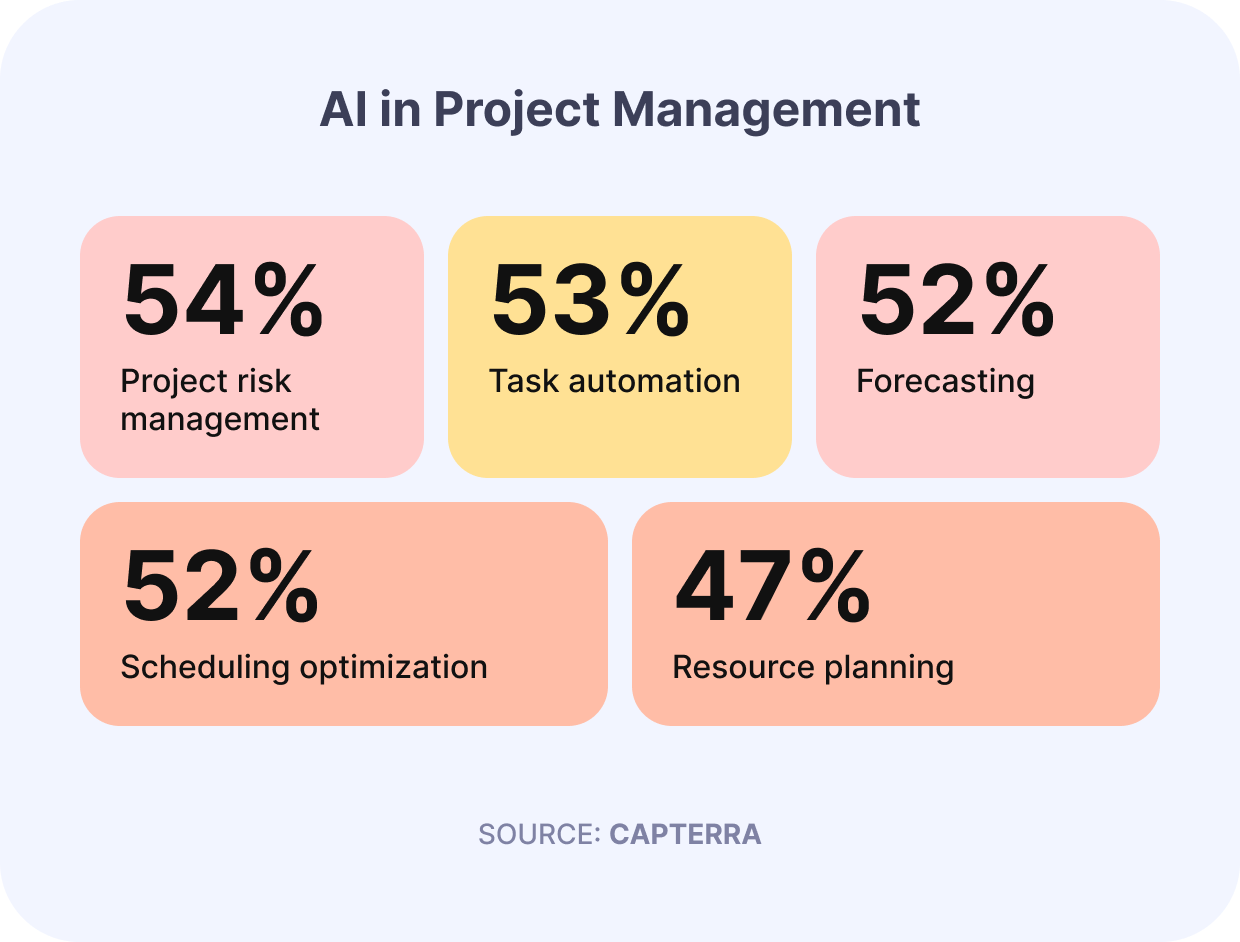
Image Source: Productive
Scenario Planning in Action: Real-World Use Cases
Scenario planning isn’t a theoretical exercise — it’s a practical necessity across industries:
- Technology Companies use forecasting tools to manage overlapping software development cycles and coordinate sprints across distributed teams.
- Construction Firms apply scenario models to predict material shortages or project delays caused by weather or supply chain issues.
- Financial Institutions rely on predictive simulations to anticipate budget overruns or workforce fluctuations in large-scale projects.
- Healthcare and Pharma use scenario analysis to plan research initiatives, clinical trials, and regulatory timelines while managing limited skilled resources.
In each case, the combination of forecasting and scenario modeling enables smarter risk management and more reliable delivery timelines, even in unpredictable environments.
Choosing the Right Project Management Forecasting Software
Selecting the right forecasting tool is just as important as implementing it. Organizations should evaluate solutions based on these criteria:
- Integration Capabilities – The software should easily integrate with existing tools like Jira, MS Project, or Salesforce to centralize data.
- Scalability – It must support growth, from small teams to enterprise-level portfolios.
- Ease of Use – A user-friendly interface ensures adoption across departments.
- Predictive & Analytical Power – Advanced analytics and AI-based insights should drive smarter forecasting.
- Customizable Dashboards – Real-time visibility of KPIs, workloads, and timelines for data-backed decision-making.
- Security & Compliance – Strong data protection standards to maintain project confidentiality.
Choosing software that meets these benchmarks ensures organizations get long-term value rather than just short-term convenience.
Future of Scenario Planning and Forecasting in Project Management
The future of project portfolio management is moving toward predictive and autonomous systems. Emerging trends show how technology is reshaping the landscape:
- Generative AI will soon assist in crafting optimal project plans and generating alternative schedules automatically.
- Digital Twins of projects will simulate the entire portfolio in a virtual space, allowing experimentation before real-world execution.
- Autonomous Project Management Systems will independently adjust timelines and resource assignments as conditions evolve.
- Cross-Platform Analytics will connect financial, HR, and operational data to offer a unified picture of organizational performance.
As these innovations mature, project forecasting software will become less of a support tool and more of a strategic partner — capable of self-correcting and guiding projects toward successful outcomes.
How DashClicks’ Project Management Software Enhances Forecasting and Scenario Planning?
To make accurate forecasts and actionable plans, you need more than data—you need organization, visibility, and execution control. That’s where DashClicks’ Projects Management Software comes in.
It provides a unified workspace for teams and agencies to plan, track, and optimize every project with clarity and precision. Key benefits include:
- Task & Workflow Automation: Streamline repetitive tasks and focus on high-impact activities.
- Resource Management: Assign workloads intelligently and monitor team utilization in real time.
- Real-Time Collaboration: Keep every stakeholder aligned through shared dashboards and instant updates.
- Performance Tracking: Monitor progress and KPIs with in-depth reporting and analytics.
- Client Transparency: Deliver complete visibility into project progress through branded dashboards—ideal for agencies handling multiple clients.
By combining scenario planning with powerful execution tools, DashClicks ensures your projects stay predictable, measurable, and scalable—turning strategic forecasts into tangible outcomes.
Summary and Concluding Thoughts
Using project management forecasting software plays an important role in navigating risks and fighting the uncertainty. Scenario planning and forecasting software empowers organizations to:
- Run different scenarios and see potential outcomes before changes are made.
- Effectively balance resources across the portfolio.
- Quickly adjust to changes, increasing ROI.
- Effectively manage and prevent risks.
Adopting these tools helps companies to deliver more value with the same resources to stay competitive and expand into new markets. A project management forecasting software gives an excellent opportunity to enterprises that are looking for new innovative instruments to succeed.
Frequently Asked Questions (FAQ)
Q1. Why is forecasting software important in project portfolio management?
Ans. Project management forecasting software is important because it gives leaders real-time data-driven insights and helps to predict resource needs, delivery dates, and risks before they affect the portfolio.
Q2. What are the main features of project management forecasting software?
Ans. The main features include what-if scenario planning, workload forecasting, advanced predictive analysis, AI agent project managers, and automatic schedule adjusting.
Q3. How does scenario planning software improve project decision-making?
Ans. Scenario planning software allows project managers to test multiple “what-if” situations before making decisions. This ensures choices are based on data, not assumptions, minimizing risks and costly missteps.


White Label SEO Reselling: The Fastest Path to Agency Growth
Imagine this: a small web design agency signs a few SEO clients but quickly realizes they can’t keep up with demand. Instead of hiring staff or outsourcing piecemeal to freelancers, they partner with a white label SEO provider. Within months, SEO revenue becomes their biggest profit center, client retention skyrockets, and their brand reputation strengthens. This story isn’t rare—it’s the new reality for agencies leveraging white label SEO services.
It can be exciting and challenging when people ask for services you don't offer, like SEO, as a digital marketing business owner. That's why white label SEO reselling is useful. It's like having a group of SEO pros work for your business without you having to hire, train, or direct them. This plan saves you time and revenue and helps you grow your business more quickly, keep your clients happy, and make a greater profit. It might be best for your business to grow if you become a white label SEO provider.
Why Agencies Are Turning to White Label SEO in 2025?
- The Growing Demand for SEO Services: The global SEO services market is expected to surpass $127 billion by 2030, reflecting a steady 12.3% CAGR. This rapid growth is fueled by businesses realizing they can’t survive online without visibility. For agencies, it means more clients asking about SEO—even if it’s not your core service.
- The Resource Challenge for Agencies: Hiring an in-house SEO team requires salaries, tools, training, and HR overhead. Smaller agencies often can’t justify those costs. White label SEO bridges this gap by giving them access to senior SEO specialists without the financial burden.
- White Label SEO as the Competitive Equalizer:
When agencies tap into white label SEO, they suddenly gain the ability to compete with larger, established players. Even boutique agencies can pitch enterprise-level SEO packages with confidence, knowing delivery will be handled by experts.
Why It Makes Sense to Use White Label SEO Now?
Outsourcing SEO through white label SEO providers allows businesses to quickly add more services while keeping costs low. It offers instant access to specialists, reduces hiring overhead, and facilitates testing new services without the need for lengthy ramp-up periods.
When agencies add white label SEO, they often get their clients back faster and keep them longer. New reports from the industry also show that companies that use white label SEO can make a lot more money in their first year.
The Real Benefits of White Label SEO for Agencies
- Cost Efficiency Beyond Salaries: Beyond wages, SEO operations require paid tools (like Ahrefs, Semrush, SurferSEO), analytics platforms, and content production. White label SEO partners absorb these costs, allowing agencies to scale without upfront investments.
- Access to Specialized Expertise: SEO is broad—covering technical SEO, local SEO, e-commerce SEO, and more. White label SEO providers typically staff experts across niches, ensuring your clients get advanced insights your internal team might not have.
- Faster Time-to-Market: Instead of spending months building a service line, agencies can launch SEO packages almost instantly. This allows them to capitalize on client interest right away.
- Client Retention & Expansion: Clients want one partner to cover multiple marketing needs. By offering SEO alongside PPC, social, or web design, agencies become a “one-stop solution,” which increases retention and upsell opportunities.
How to Grow Your Agency?
Step 1: Choose Your Products and Market Category
Do not try to sell everything at the start. Choose two or three packages that are tailored to your current clients.
- Local SEO: It includes optimizing your Google Business Profile and adding local links. This is great for small businesses in the area.
- Content + On-Page SEO: blog posts, landing pages, and on-page optimization are great for service and e-commerce companies.
- Technical SEO: Site audits, speed improvements, and schema are all helpful for bigger sites and SaaS.
- Link Building and Outreach: This is for niche companies competing with others.
Add more services once you know your processes and partner work well. Start with the core packages first.
Step 2: Check Out and Pick the Best White Label SEO Partner
The most important choice you'll make is who you'll be with. Think of this process as hiring a partner for a long time. You should ask for case studies and accurate performance statistics. Make sure they offer unique reports and customizable client dashboards.
Test how fast they can communicate and deliver with a small job. Also, see if they can handle much work during busy times. A good screening method protects your brand's reputation and helps avoid quality problems. Many companies recommend trying it for 3-4 weeks before committing fully.
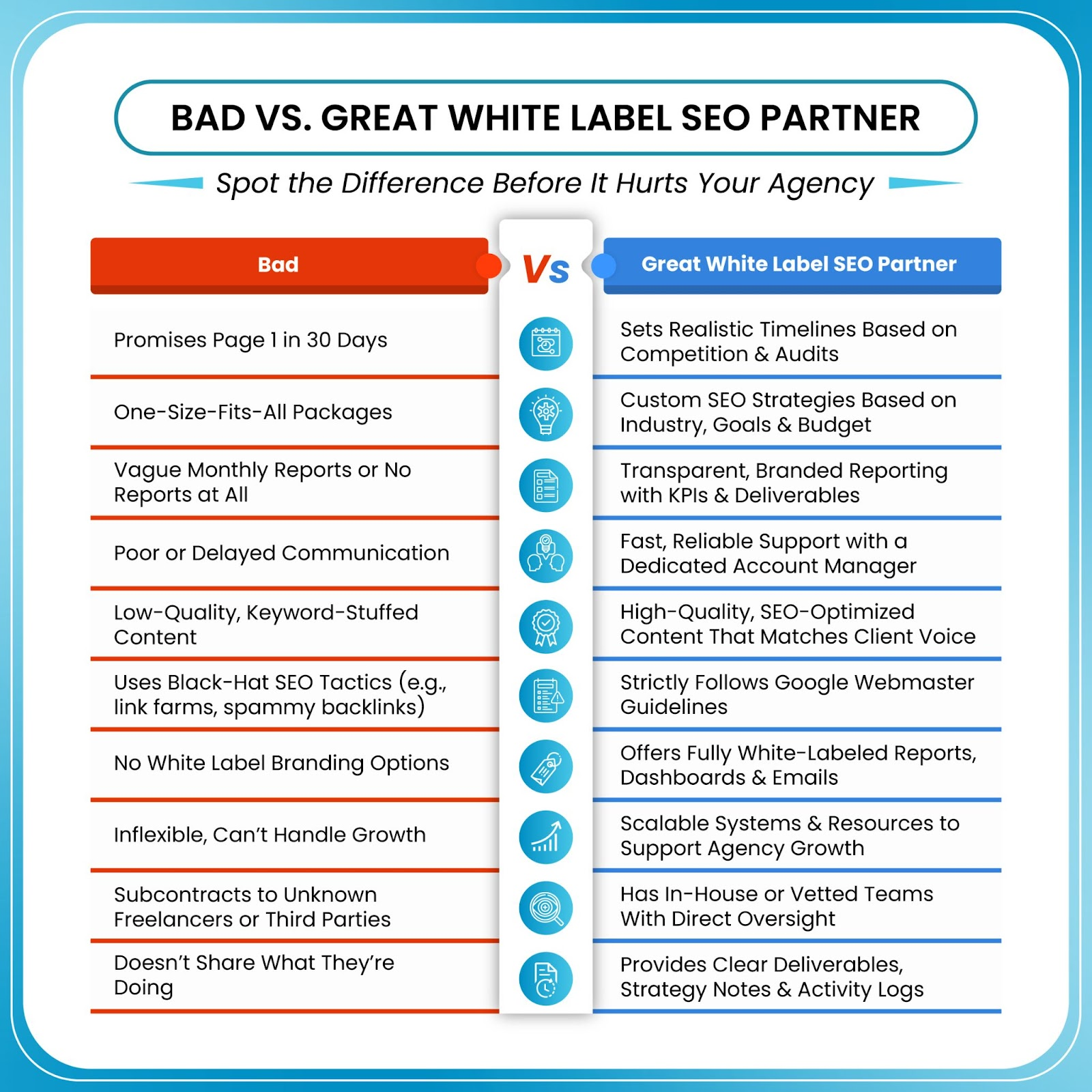
Step 3: Clarify Packages and Pricing to Protect Margins
Provide simple packages with levels like Starter, Growth, and Pro. Make it clear what each package includes, like technology fixes, content creation, managing local listings, building links, core SEO services, and monthly reports with strategy calls.
Cover the provider's cost, your time spent managing the account, and your profit when you set the price. Stay away from big deals that cut into your profit margins. Having healthy margins will help you provide good service.
Step 4: Make a System for Easy Onboarding
A well-organized onboarding method keeps things clear and saves time. Start with a client intake form to write down their goals and get their qualifications. First, check out the site and list things that must be done.
Scope, dates, and KPIs should all be agreed upon before work begins. Integrate a direct mail API to automate communications and ensure timely delivery of important documents, and use a contact enrichment API to automatically enrich or sync client data during onboarding.. Share a delivery plan and agree on a time to report every month. Every client will have the same professional experience if you use templates for emails like welcome ones, requests for access, and progress updates. Consider pairing these templates with an email signature manager to ensure consistent branding and professional communication across all client interactions.
Step 5: Customized Reports and Tools
Maintaining a smooth experience for your client is made easier with white-labeled reports. You should use tools like Zoviz.com to create a professional logo that can be added to PDFs and panels. Show results, traffic, and ROI in automated reports that come out once a week or monthly.
Results should always be shown in business terms, like leads, sales, and conversions, not just SEO data. Getting one good feedback tool that can be changed will save time and help build trust. You can also integrate a coworking app to streamline communication, reporting, and client management in one place.
Step 6: Own Client Relationship
Your company should own the connection, even if your partner does the work. Take care of the person all by yourself. Turn SEO results into real business benefits, like more leads or sales. Plan strategy calls once a month, deal with changes to the project's scope, and quickly fix any quality problems that come up. Also, let your business know that SEO takes time, usually between 3 and 6 months. With good account management, a reseller can become a reliable consultant.
Step 7: Protect Your Data, IP, and Legal Rights
Clear contracts will keep your business safe. You should sign a confidentiality agreement (NDA) and a reseller agreement that covers intellectual property, tasks, and service-level agreements (SLAs). Ensure that reports and content that can be rebranded officially belong to you. Also, ensure your partner follows privacy rules and tells you how they handle client data. These safety measures are important for your brand's image.
Step 8: Make It Bigger Without Losing Quality
Keep your process the same when you're ready to grow. Keep your onboarding and package standards consistent. It will save you time when automating billing and reports. Assign someone in your service to oversee work with partners. Track important numbers like Net Promoter Score (NPS), delivery times, and the percentage of clients who stay with the business. To improve the value of a client over their lifetime, offer related services like pay-per-click (PPC) or conversion rate optimization. A regular process is important for scaling, so you don't have to make it from scratch for each client.
How White Label SEO Fits Into a Multi-Service Agency?
- Bundling With PPC and Social Media: SEO doesn’t exist in isolation. White label SEO providers can create strategies that complement paid campaigns—like improving landing page quality scores for PPC or boosting organic reach for social content.
- Enhancing Web Design Projects: Design agencies often face the issue of clients asking, “Will my new website rank?” With white label SEO, agencies can confidently answer yes, offering both design and optimization in one package.
- SEO + Content Marketing Synergy: Content is the backbone of SEO. Agencies already producing blogs or social posts can amplify results by plugging into SEO-focused content plans from their white label SEO partners.

Common Mistakes to Avoid
- When looking for a partner, don't just go with the cheaper one; quality is more important than a small fee.
- Excessive results promise to make sure that plans and metrics are communicated.
- You should always give each account at your business a strong internal owner.
- There is no pilot phase; the provider is tested with one customer before it is rolled out to all clients.
DashClicks: Your Partner for Scalable White Label SEO
DashClicks offers end-to-end white label SEO services designed specifically for agencies that want to scale without hiring in-house teams. From keyword research and on-page optimization to link building and technical audits, their SEO services are delivered by seasoned experts who follow proven SOPs. What makes DashClicks stand out is its white-labeled client dashboard, where you can track rankings, traffic, and backlinks—all branded with your agency’s logo.
Instead of juggling multiple vendors or worrying about quality control, you get a streamlined, cost-effective solution that allows you to focus on client relationships while DashClicks handles the execution. With predictable results, transparent reporting, and affordable scalability, DashClicks helps agencies boost margins, retain more clients, and confidently compete with bigger players in the digital space.
Wrapping It Up
White label SEO has been used for a long time and is a safe way to quickly grow your agency's services. You can make more revenue, keep customers happy, and offer more services without having to pay for a full SEO team if you have the right partner, clear processes, and strict account management. Changes happen quickly in the market. In the long term, companies that move carefully and put quality first will win.
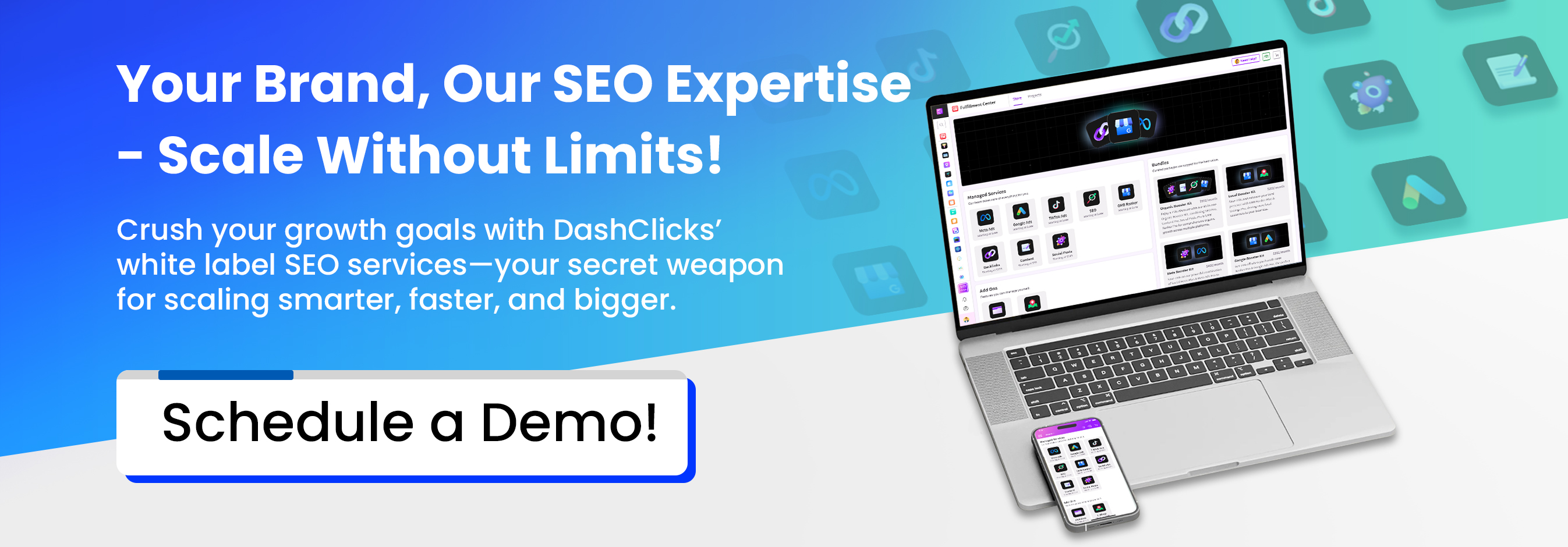

White Label SEO: Your Agency's 7-Figure Blueprint
Here’s a fact that should stop you in your tracks: Agencies leveraging White Label SEO see average revenue growth of 32%. That’s not just outsourcing; it’s a strategic business model.
That’s not just outsourcing—it’s a proven scaling model.
If you’ve been in the agency world for any amount of time, you already know the struggle: the market demands full-service digital marketing—SEO, PPC, content, social media, web design—but the reality of building a specialized in-house team to deliver it all? That’s a resource drain most small to mid-sized agencies simply can’t sustain.
In fact, 37% of agencies cite client acquisition as their single biggest growth barrier. You might recognize this feeling:
- You land new clients, but fulfillment starts eating your time.
- You consider hiring SEO specialists, but salaries + benefits slash your margins.
- You experiment with freelancers, but the quality and deadlines are inconsistent.
And before long, you’re stuck in a cycle of juggling sales, client calls, and delivery—without ever building a scalable engine for growth.
Here’s the truth: what gets an agency to $30k/month won’t get it to $100k/month. To break through that ceiling, you need leverage.
That’s where white label SEO services come in. More than a way to outsource, it’s the growth blueprint that allows you to scale services, increase profitability, and deliver expert-level results—without bloating your payroll or burning out your team.
This guide will give you the exact framework: a step-by-step blueprint for transforming your agency into a 7-figure machine in 2025 using white label SEO. We’ll cover the bottlenecks keeping most agencies stuck, the five “growth gears” that power million-dollar operations, and a 90-day plan to start scaling immediately.
Breaking the 6-Figure Ceiling: Why Agencies Get Stuck
The Bottleneck Problem: The Founder Does Everything
In the early stages, the agency owner wears every hat—salesperson, strategist, account manager, copywriter, even the one fixing broken meta tags at midnight. This hustle works when you have 3–5 clients. But once you hit 10+ accounts, the agency grinds to a halt.
Every proposal, client email, and keyword plan has to go through one person—you. Delivery slows. Clients feel neglected. Growth depends on how many hours you can put in.
At first, this makes sense. You need to understand every moving part of your business. But as you scale past a handful of clients, this model collapses.
You become the bottleneck. Deals stop closing because you’re buried in client work. Fulfillment slips because you’re stuck in sales calls. The harder you work, the more you stall growth.
The Capacity Trap: Hiring Too Early
Some agency owners try to solve the bottleneck by hiring in-house staff. The problem? In-house SEO talent doesn’t come cheap.
- SEO Specialist: $50k–$70k/year
- Content Writer: $40k–$60k/year
- Link Builder / Outreach: $35k–$50k/year
That’s over $150k/year in overhead—before benefits, training, and management time. For an agency still hovering at $30k/month, those salaries can crush profit margins.
Instead of scaling, you end up running just to keep payroll covered.
The Project-Based Revenue Plateau
Another silent killer is relying too heavily on project-based work: one-off website builds, audits, or campaigns.
Projects might give you cash flow, but they don’t create stability. To grow, you need Monthly Recurring Revenue (MRR). That means retainers—SEO retainers especially—because they compound over time.
Without MRR, your agency will always be trapped in a feast-or-famine cycle.
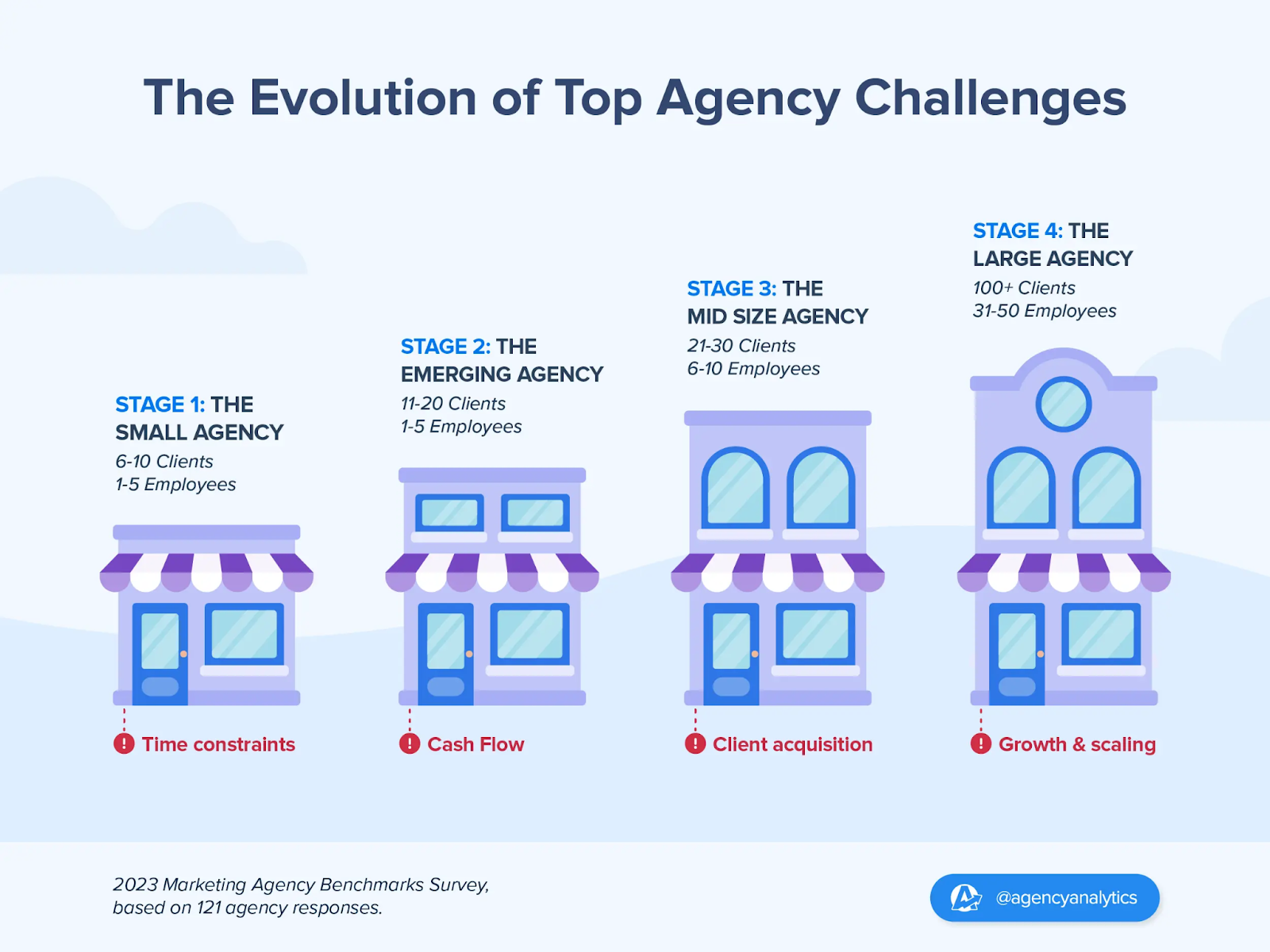
Image Source: AgencyAnalytics
The Shift You Need: Systems + Partnerships
Here’s the real breakthrough: scaling to 7 figures isn’t about working harder, hiring faster, or chasing bigger projects. It’s about:
- Building systems for sales, fulfillment, and client management.
- Leveraging partnerships—specifically, white label SEO - to expand your capacity without ballooning costs.
Imagine this:
- Your sales team closes SEO retainers confidently.
- Fulfillment is handled by a trusted white label partner with proven SOPs.
- Clients get results, your agency keeps margins healthy, and you stay focused on growth levers.
That’s how agencies break through the 6-figure ceiling—and start building toward 7 figures.
Example: An agency owner at $30k/month with 12 clients spends 80% of their time managing freelancers. Burnout kicks in before hitting $50k. But by shifting to a white label SEO partner, they free up 60% of their time, productize SEO services into packages, and double client capacity within six months—without hiring in-house.
White Label SEO as the Hidden Growth Lever
Let’s get one thing clear: white label SEO isn’t just outsourcing. It’s about building a scalable fulfillment engine that runs behind the scenes while your agency focuses on front-end growth. Look at the stats:
- 63% of agencies report higher profit margins using white label solutions.
- 70% note improved client retention, thanks to consistent deliverables from White Label SEO providers (source: SEO Discovery).
Key Benefits of White Label SEO:
- Leverage Expertise Without Overhead: Scale operations immediately without hiring expensive in-house staff. White Label SEO partners provide pre-trained, experienced teams ready for execution.
- Expand Revenue Opportunities: Convert project-based relationships into recurring SEO retainers. Upsell existing services like PPC or social media with SEO for a broader client offering.
- Simplify Workflow Management: With dedicated fulfillment teams, agencies avoid freelancer inconsistencies or internal training limitations.
- Enhance Reputation: Elevate your agency as a full-service digital marketing expert.
- Better Profitability: Reduce unnecessary overhead while increasing your gross margins per project.
Pitfalls to Avoid
Not all White Label SEO service providers align with your agency's standards. Vetting matters. Look for:
- Transparent Reporting
- Clear Processes
- Alignment With Your Branding
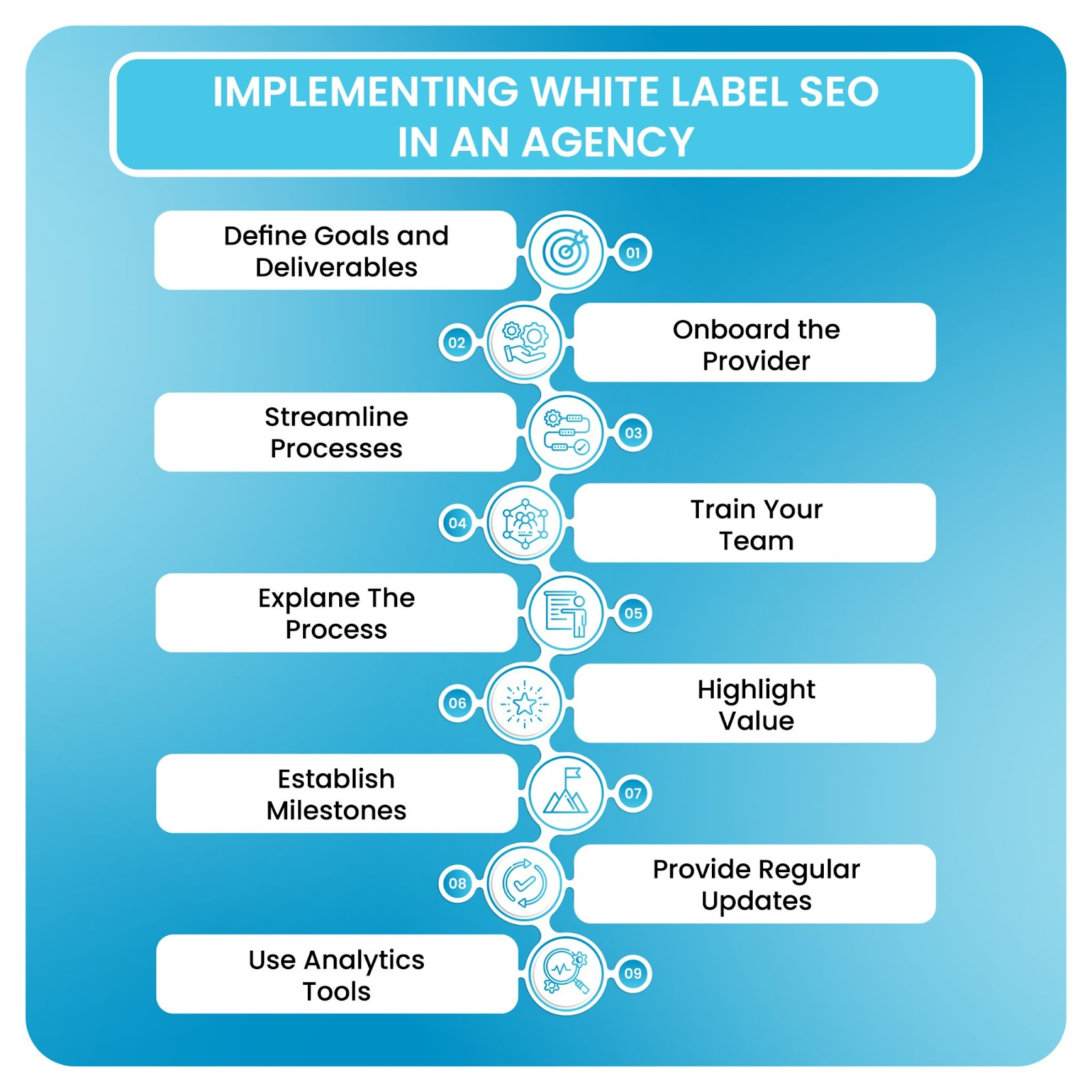
The 5 Growth Gears of a 7-Figure Agency
Breaking into 7 figures doesn’t happen by accident. It happens when agencies turn the right “growth gears.” Here’s the blueprint:
Gear 1: Productized SEO Services
Don’t sell SEO as a vague “service.” Package it. Create clear tiers (Starter, Growth, Domination) with deliverables, timelines, and expected outcomes. White label SEO partners make this easy—they give you the backend to fulfill consistent packages at scale.
Gear 2: Recurring Revenue Engine
Shift clients from one-off projects to retainers. SEO works best long-term—position it as an investment, not a campaign. A predictable MRR base allows you to plan hiring, marketing, and expansion confidently.
Gear 3: Sales Team Leverage
The founder can’t sell everything forever. Build a repeatable sales system:
- Scripts, decks, and proposal templates
- A CRM with automated follow-ups
- Commission structures to motivate closers
With white label SEO, your sales team can confidently pitch SEO—even if they aren’t SEO experts—because fulfillment is guaranteed.
Gear 4: Client Education & Transparency
Clients leave agencies when they don’t understand the value. Great agencies explain:
- SEO timelines (4–6 months to see compounding results).
- What progress looks like beyond rankings (traffic, conversions, visibility).
- How SEO integrates with other channels (content, PPC, local).
The more educated your client, the longer they stay.
Gear 5: Scalable Fulfillment
This is the heart of it. Without scalable fulfillment, growth breaks. White label SEO company solves this by giving you unlimited bandwidth—you can onboard 1 client or 10 without breaking delivery quality.
Why SEO Is the Multiplier (Not Just Another Service)?
Most agencies treat SEO as one service among many. In reality, SEO is the multiplier—it compounds results, strengthens other channels, and keeps clients longer than almost anything else you can offer.
- Compounding ROI: With PPC, results reset the moment the spend stops. SEO is different—it builds equity. Every blog, backlink, and technical fix makes the site stronger, and rankings continue to compound like interest over time. Instead of paying for clicks that vanish tomorrow, clients are investing in long-term visibility.
- Cross-Channel Impact: SEO research gives you keyword data, intent signals, and competitor insights. That same intelligence makes PPC targeting sharper, content strategy smarter, and even social campaigns more relevant. In other words, SEO isn’t just traffic—it’s the foundation of smarter marketing decisions.
- Retention Anchor: When budgets get tight, ad spend is often the first thing to go. But SEO feels like infrastructure—clients know stopping could undo months of progress. That’s why agencies that lead with SEO typically enjoy retention cycles of 12–24 months vs. the 3–6 months common with ad-only clients.
- Bundled Power: SEO also makes upselling easier. Start with a $2k SEO retainer, then layer PPC, social, or listings on top. Suddenly, that client isn’t worth $2k—they’re worth $8–10k per month. SEO keeps them in the door; other services stack on revenue.
Quick Example: One local agency signed a boutique retailer at $2k/month for SEO. After six months, the client ranked for multiple “near me” searches and saw a 40% lift in store visits. The agency used that SEO data to launch a targeted PPC campaign and later added social ads. Within a year, that $2k client grew into a $10k/month partner—and stayed for three years.
Bottom line: SEO isn’t just another service. It compounds results, powers other channels, reduces churn, and opens the door to high-value bundles. For agencies aiming to scale, SEO is the multiplier that makes the model work.
Delivery at Scale: From Freelancer Chaos to Agency Systems
Every growing agency hits the same wall: delivery. You can sell all the SEO retainers you want, but if the backend fulfillment can’t keep up, clients notice—and churn.
The Freelancer Model Pitfalls
Many agencies start with freelancers because it feels flexible and low-cost. But soon the cracks show:
- Inconsistent Quality: One freelancer nails on-page SEO, another submits keyword-stuffed copy that you’d never show a client.
- Missed Deadlines: You’re at the mercy of their schedules, side projects, and time zones.
- Zero Accountability: If they disappear, the client deliverable disappears with them.
Relying solely on freelancers might work when you’re managing two or three accounts, but it’s a recipe for chaos at scale.
The In-House Dilemma
The alternative—building a full in-house team—sounds great in theory but creates its own problems:
- High Overhead: SEO strategists, writers, designers, and link builders all come with salaries and benefits.
- Training Burden: Every new hire requires onboarding into your agency’s process.
- Capacity Gaps: One or two client churns can leave team members underutilized, killing margins.
For most agencies under $5M ARR, the in-house-first approach makes scaling clunky and risky.
The White Label SEO Advantage
This is where white label SEO outsourcing changes the game. Instead of reinventing the wheel, you plug into a partner with:
- Pre-built SOPs: Proven workflows for keyword research, content creation, link building, and reporting.
- Dedicated teams: Specialists for technical SEO, writers for optimized content, and link builders with established networks.
- Automated reporting: Client-facing dashboards that update in real-time, keeping you transparent without extra work.
With white label SEO, delivery isn’t just “done”—it’s done at scale, with consistency and efficiency you could never match juggling freelancers or early-stage in-house teams.

Action Steps to Systemize Delivery
If you’re serious about scaling, fulfillment needs to be productized and system-driven:
- Standardize Onboarding: Create a repeatable intake process so every client enters with the same information, expectations, and timelines.
- Productize Your Services: Sell SEO as packages (e.g., Bronze, Silver, Gold) with fixed deliverables instead of one-off custom projects. This makes pricing predictable and fulfillment scalable.
- Delegate Fulfillment: Free yourself from the weeds by offloading 60–70% of production. Use that time to focus on growth—sales, partnerships, and client relationships.
The Agency Growth Engine: DashClicks’ White Label SEO Services
If you’re looking for a trusted White Label SEO services, DashClicks makes scaling simple. Designed for agencies, it removes fulfillment headaches so you can deliver high-quality SEO without overloading your team.
- Proven Processes: With pre-built SOPs, every task—whether it’s onboarding, audits, or backlink campaigns—follows structured, repeatable steps. That means fewer errors and consistent results that clients can rely on.
- Branded Tools: DashClicks provides client-facing dashboards fully white-labeled with your agency’s logo. Rankings, traffic, and backlinks are all tracked in one sleek portal, so reporting looks seamless and professional.
- All-in-One SEO: From keyword research and on-page optimization to technical audits and link building, everything is bundled into one streamlined system—no juggling freelancers or vendors.
- Cost-Effective Scaling: Instead of hiring and training an in-house SEO team, agencies can tap into DashClicks’ fulfillment at a fraction of the cost, paying only for what’s needed.
DashClicks helps you focus on growth, while they handle execution. The result? Stronger branding, happier clients, and a scalable path to profitability.
Your 90-Day Acceleration Plan
Weeks 1–2: Audit & Align
- Audit margins, delivery gaps, and client mix.
- Define 3 SEO packages; map costs and target margins.
- Shortlist white label SEO partners; align SOPs and reporting.
Weeks 3–4: Pilot & Productize
- Test with 1–2 clients (low risk, high visibility).
- Build sales collateral (decks, one-pagers, proposal language).
- Set reporting cadence and QBR templates.
Month 2: Sell & Systemize
- Train sales on discovery → demo → close.
- Upsell existing clients; launch outbound to one niche.
- Automate onboarding (intake forms, access checklists).
Month 3: Scale & Optimize
- Add content calendar pipelines; lock sprint rituals.
- Track retention KPIs, COGS, and time-to-first-value.
- Refine offers based on pilot feedback.
By Day 90: A repeatable SEO offer, elastic fulfillment, branded reporting, and predictable MRR.
From Hustler to CEO: The Agency Owner’s Mindset Shift
Breaking into seven figures isn’t just about better systems—it’s about the owner stepping out of hustle mode. Many agencies stall because the founder is stuck doing tasks that could be delegated.
Hustler Mindset → CEO Mindset
- Hustler: Says yes to everything, manages delivery, sells time.
- CEO: Designs systems, delegates fulfillment, sells outcomes.
The CEO role requires a shift in focus:
- Stop selling hours; sell outcomes with clear deliverables.
- Replace ad-hoc workflows with SOPs & playbooks.
- Hire or appoint an ops person to own onboarding and retention metrics.
- Incentivize retention (comp plans that reward renewals and upsells).
Culture of Retention: Celebrate renewals and expansion as wins. Aim for longer average contract lifetimes and higher LTV.
This mindset shift is the difference between running an agency that feels like a job and owning an agency that scales like a business.
Conclusion: Activating Your 7-Figure Growth Engine
Growing past six figures isn’t about doing more—it’s about scaling smarter. White label SEO outsourcing removes overhead, boosts profit margins, and delivers expert-level results without the cost of building an in-house team.
The blueprint is simple: understand the model, run the numbers, choose the right partner, and build seamless workflows. Do this, and your agency gains predictable growth, stronger client retention, and the freedom to focus on sales and strategy.
With the right white label SEO partner, your path to 7-figure success is not just possible—it’s inevitable.
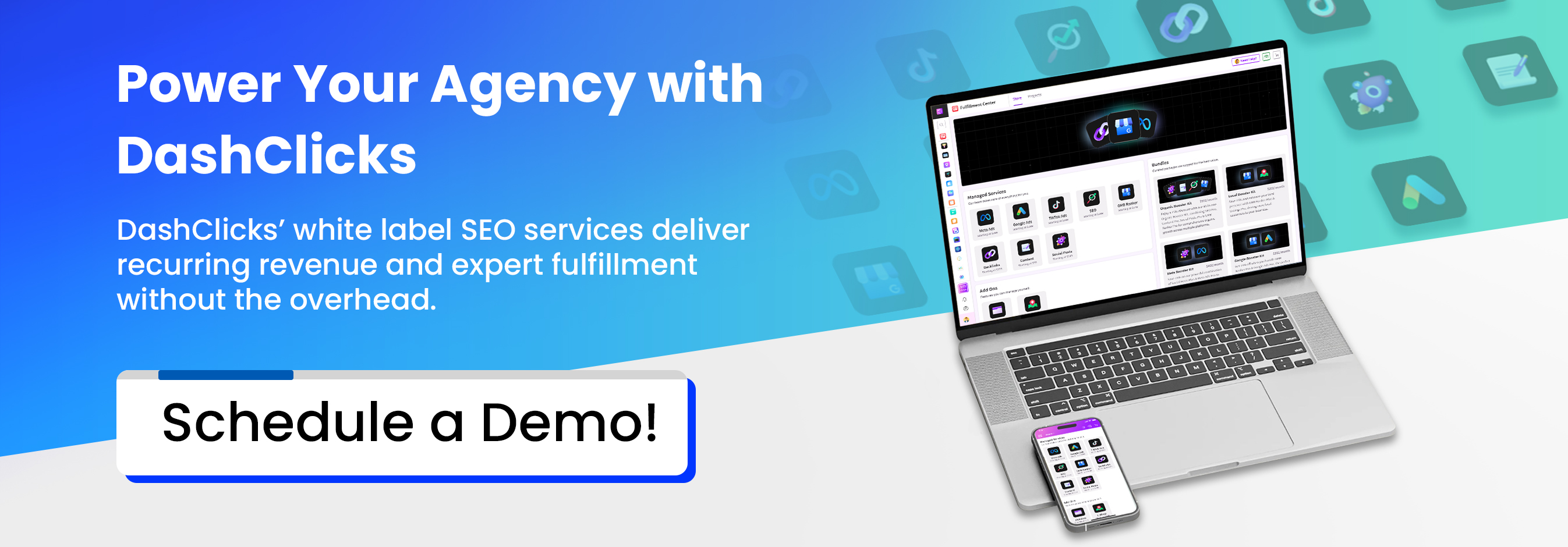

Optimizing Digital Assets for Better White Label SEO Results
Just having great content or products isn’t enough anymore. You need to make sure people actually see them. For white label businesses, that means paying attention to every digital asset you put out there.
From images and videos to downloadable resources and web pages, each piece of content is more than just something to look at—it tells search engines what your business is about and affects how easily customers can find you. This is where white label SEO services add value — by ensuring every digital asset is fully optimized for performance, discoverability, and client branding without requiring agencies to manage all the heavy lifting themselves.
When you optimize these assets thoughtfully, you make it easier to attract the right traffic, get noticed, and boost your SEO. Whether you’re new to white label SEO solutions or looking to refine your current strategy, this article will show you practical ways to optimize your digital assets for maximum impact.
Understanding the Importance of Digital Assets in SEO
Digital assets, such as images, videos, infographics, PDFs, and other downloadable content, play an important role in SEO. They aren’t just supplementary or visual elements; they help search engines understand your content, improve user experience, and increase engagement.
Optimized digital assets can reduce page load times, improve accessibility, and provide valuable metadata that increases search rankings. For white label businesses, this becomes even more critical, as the quality and discoverability of your assets directly impact client visibility and credibility. Partnering with white label SEO services can make this process seamless, as they bring proven frameworks for optimizing digital assets while scaling efforts across multiple clients.
Using High-Quality Imagery
Using high-quality imagery is essential for improving SEO and engaging visitors on your website. Clear, professional visuals not only capture attention but also communicate trust and credibility, which is especially important for white label and e-commerce platforms.
Optimized images improve page load speeds, support mobile responsiveness, and can be indexed by search engines to drive organic traffic. Incorporating descriptive filenames, alt text, and captions further boosts SEO value.
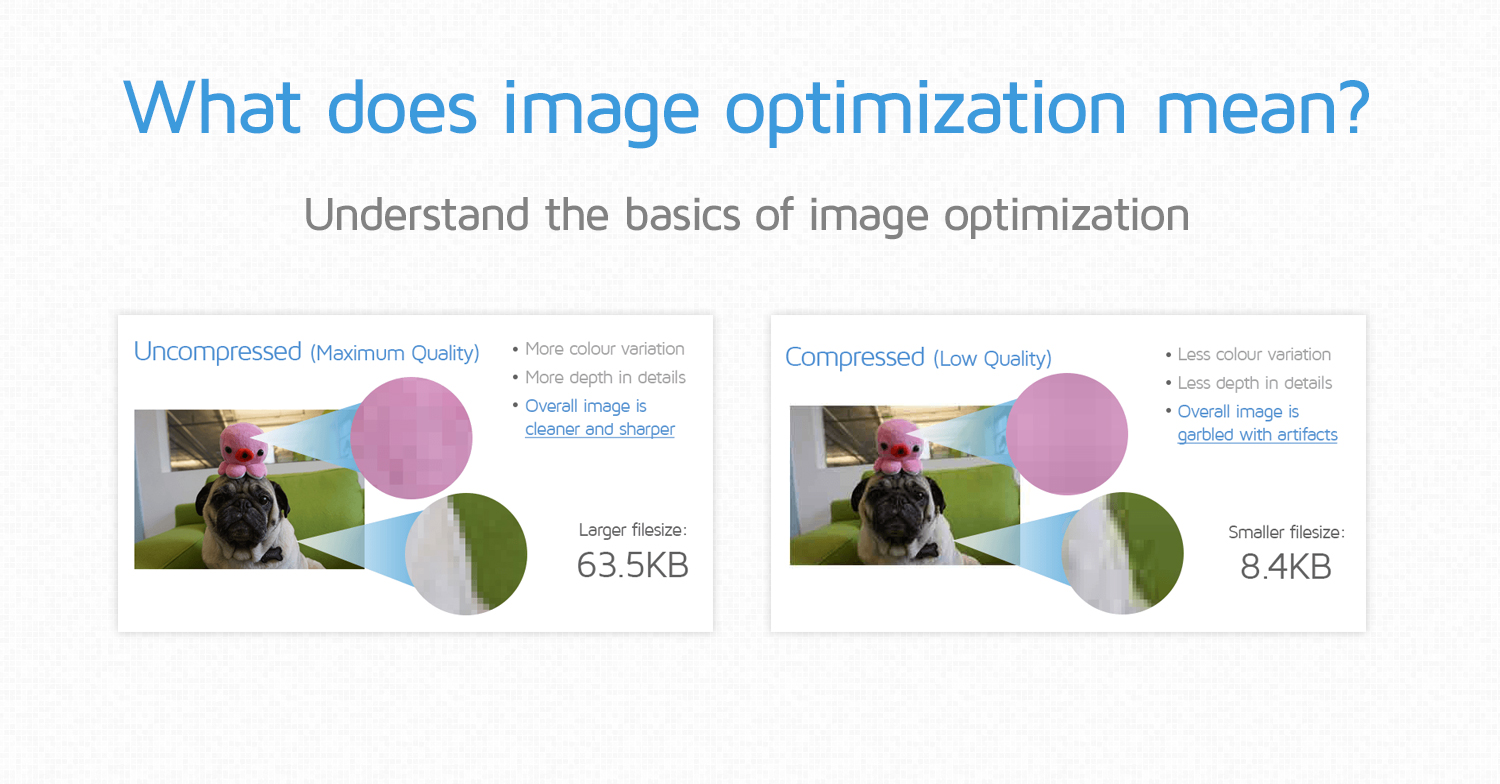
Image Source: GTmetrix
For online stores, stunning product visuals for e-commerce can significantly influence purchasing decisions while improving search visibility. White label SEO outsourcing can even help agencies package and optimize client resources—like case studies and reports—ensuring they drive both brand authority and organic visibility.
By investing in high-resolution images that are properly compressed and tagged, businesses ensure that their digital assets are both visually appealing and SEO-friendly, creating an excellent experience for users and a stronger presence in search engine results.
Internal Linking and Asset Structuring
Internal linking and proper asset structuring are important components of an effective SEO strategy. By organizing digital assets such as images, videos, and downloadable files into logical folders with clear naming conventions, businesses make it easier for both users and search engines to navigate their website.
Internal links make sure that valuable assets are connected to relevant pages, helping distribute authority across the website and improving indexability. For example, linking product images to category pages or blog visuals to related articles creates a smoother user journey while signaling relevance to search engines.
Proper structuring also prevents broken links, duplicate content issues, and misplaced files that could harm SEO performance. When assets are systematically organized and internally connected, businesses can improve user experience, strengthen content visibility, and achieve better rankings over time.
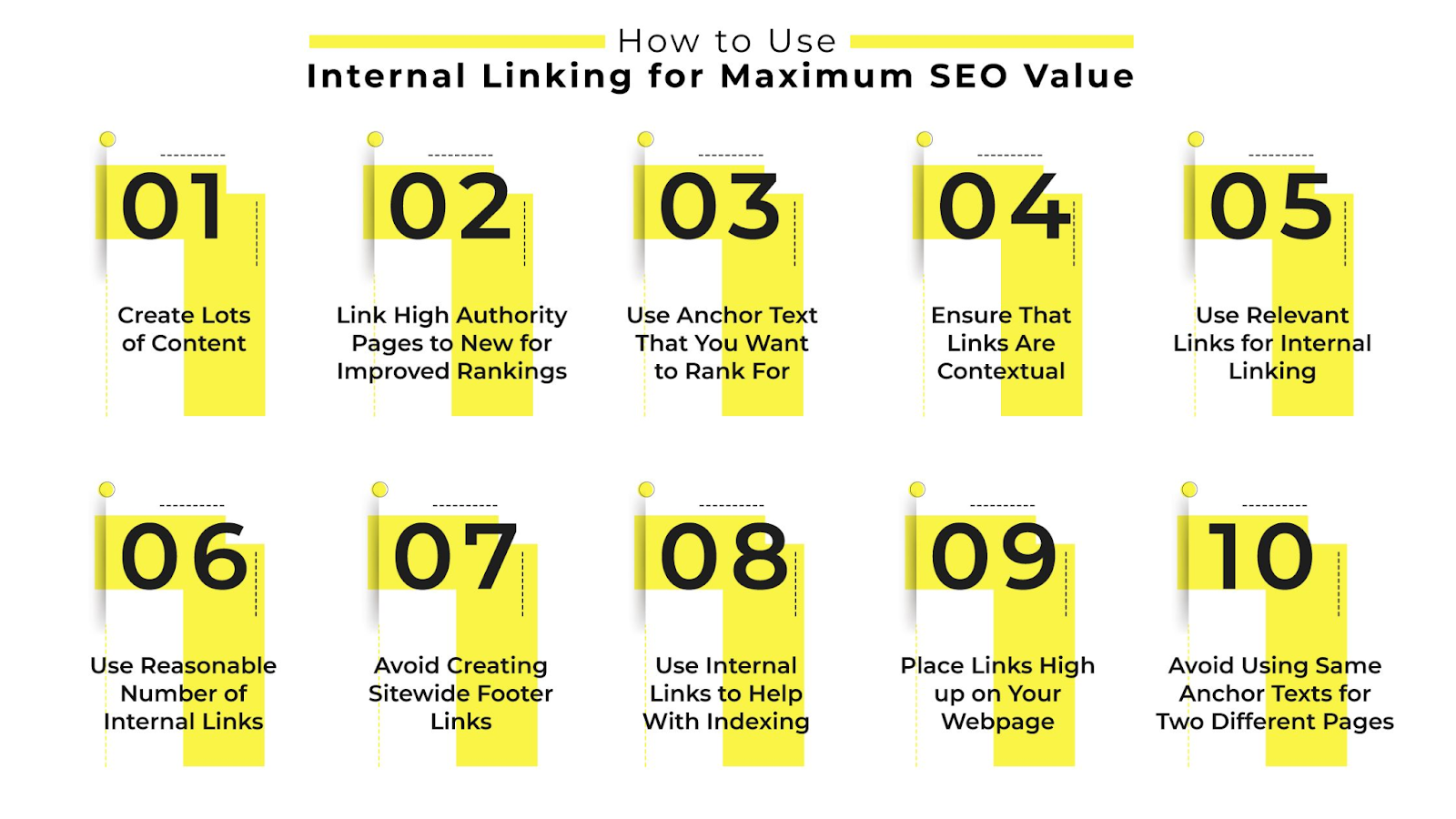
Leveraging PDFs and Documents
PDFs and documents can play an important role in boosting SEO when optimized properly. Search engines are capable of crawling PDFs, which means valuable information within them can drive organic visibility. To maximize their impact, businesses should use keyword-rich titles, headings, and metadata while ensuring file names are descriptive and easy to index.
Internal linking within PDFs can also guide readers back to key website pages, strengthening traffic flow. For user experience, lightweight, mobile-friendly, and accessible PDFs are essential. White label businesses can enhance credibility by offering branded case studies, guides, or reports in PDF format.
Additionally, maintaining updated documents is important; tools that allow you to delete pages from PDF or edit outdated content, such as Smallpdf, make sure that these assets remain relevant, accurate, and SEO-friendly. With the right approach, PDFs become more than downloads; they become searchable, valuable content hubs.
Make Content Searchable
Making content more searchable is an important step in maximizing the visibility of your digital assets. Search engines rely on clear signals, such as metadata, headings, keywords, and structured data, to understand and rank content effectively.
Organizing assets into logical categories and ensuring each has descriptive titles, tags, and alt text increases discoverability for both users and crawlers. Adding schema markup further enhances visibility by enabling rich snippets in search results.
For a white label SEO agency, making sure that all content, from product visuals to PDFs, is easy to locate strengthens brand credibility and client satisfaction. Internal search optimization within your website is equally important, helping visitors quickly find the information they need.
By making content more searchable across both external search engines and internal site searches, businesses can boost engagement, improve user experience, and drive higher-quality traffic.
Optimizing Videos for Search Visibility
Videos are among the most engaging digital assets, but without proper optimization, they may not deliver their full SEO potential. Search engines rely on contextual cues such as titles, descriptions, captions, and transcripts to understand video content.
Adding keyword-rich metadata makes sure videos rank higher in search results and on platforms like YouTube, while embedding them on relevant website pages increases dwell time and user engagement.
Optimizing file size and format also helps maintain fast load speeds, improving website performance. For white label businesses, videos that explain services, showcase products, or share tutorials can significantly boost brand authority and trust.
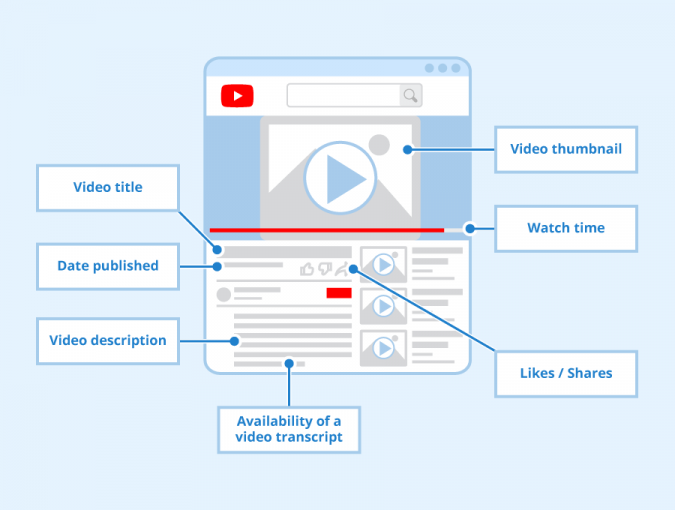
Image Source: Seobility
Incorporating schema markup makes it easier for search engines to display video snippets in results, improving click-through rates. By treating videos as strategic SEO assets, businesses can expand their reach and attract more qualified organic traffic.
Optimizing Images
Images are powerful SEO assets, but without proper optimization, they can slow down websites and limit visibility. To get the most from your visuals, start with high-resolution images that are compressed to reduce file size without sacrificing quality. The average website speed is 2.5 seconds, so anything above this might cause issues.
Always use descriptive file names and keyword-rich alt text, as these help search engines understand the context of your images while providing accessibility for all users. Implementing responsive image formats makes sure they display correctly across devices, while lazy loading improves page speed by loading visuals only when needed.
Adding images to an XML sitemap also helps search engines index them more effectively. For white label businesses, optimized visuals not only enhance SEO but also create a polished, professional brand presence.
Using Modern Image Formats
Adopting modern image formats is one of the most effective ways to balance visual quality with fast performance. Formats like WebP and AVIF provide superior compression compared to traditional JPEG or PNG files, delivering crisp visuals at a fraction of the file size.
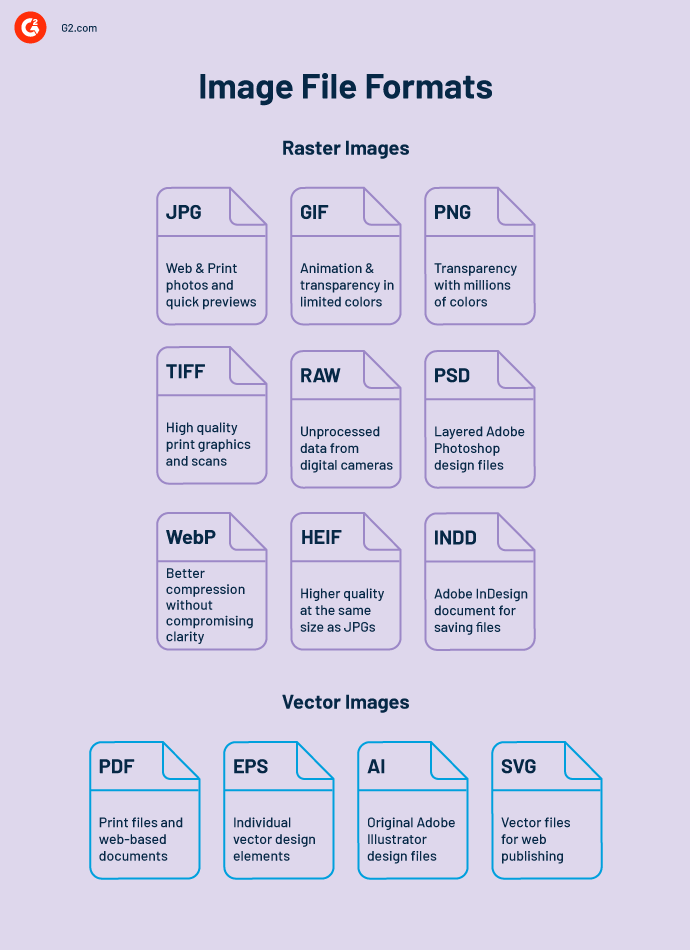
Image Source: G2
This not only improves page load speed but also improves user experience, two factors that search engines reward in their rankings. For e-commerce and white label businesses, faster-loading product and brand imagery can directly influence conversions by reducing bounce rates.
Implementing these formats alongside responsive design makes sure images display properly across all devices without slowing down the website. While legacy formats may still be necessary for compatibility in certain cases, prioritizing modern image formats wherever possible is a forward-looking strategy that supports both SEO goals and long-term digital performance.
Tracking Performance for Optimized Assets
Optimizing digital assets isn’t only effective if you measure how they perform over time. Tracking performance provides valuable insights into which assets drive the most traffic, engagement, and conversions. Heatmap platforms, Google Analytics, etc, allow businesses to monitor metrics such as impressions, click-through rates, and time spent on pages containing images, videos, or PDFs.
For white label businesses, this data helps refine strategies and demonstrate measurable SEO results for clients. For agencies, collaborating with white label SEO services makes it easier to track and report performance consistently across client accounts, demonstrating measurable SEO results at scale. Monitoring technical performance, like load speed and mobile responsiveness, also makes sure assets continue to support rather than hinder search rankings.
Also, regular audits can reveal outdated or underperforming assets, making it easier to update or repurpose them. By consistently tracking and analyzing performance, businesses can adapt quickly, maximize ROI from their digital assets, and stay ahead in the competitive SEO landscape.
How DashClicks’ White Label SEO Services Support Asset Optimization?
Managing and optimizing digital assets takes time, expertise, and consistency. This is where DashClicks’ white label SEO services become a game-changer for agencies. Instead of juggling multiple tools or stretching your in-house team thin, you can rely on DashClicks to handle everything from technical optimization to asset management — all under your agency’s brand name.
With DashClicks, every asset — whether it’s an image, video, PDF, infographic, or blog graphic — is carefully optimized to align with SEO best practices. That means faster-loading websites, properly structured metadata, keyword-rich file naming, mobile responsiveness, and even schema implementation where relevant. These details may seem small, but together they significantly increase visibility, improve search rankings, and deliver a seamless user experience that clients notice.
The best part? Agencies get to scale without adding overhead. DashClicks provides a fully managed, white-labeled solution so you can present polished, SEO-ready work directly to your clients while focusing on growth and strategy. By partnering with DashClicks, agencies not only save time but also strengthen client trust, boost retention, and consistently deliver measurable SEO results across all digital assets.
Optimizing Digital Assets Is No Longer Just a Bonus
For white label providers, well-structured and optimized assets demonstrate professionalism, enhance client visibility, and deliver measurable results.
From using high-quality imagery and modern file formats to leveraging PDFs, videos, and internal linking strategies, each element contributes to stronger search performance and a more engaging user experience.
Tracking asset performance and ensuring content is searchable ensures long-term success, allowing businesses to adapt quickly in an ever-changing digital landscape.
By investing in optimization across all asset types, white label businesses not only improve rankings but also build trust, increase conversions, and secure a lasting competitive edge in the world of SEO. By combining optimized assets with the expertise of white label SEO services, agencies can deliver improved rankings, stronger client trust, and measurable long-term success without overstretching internal resources.
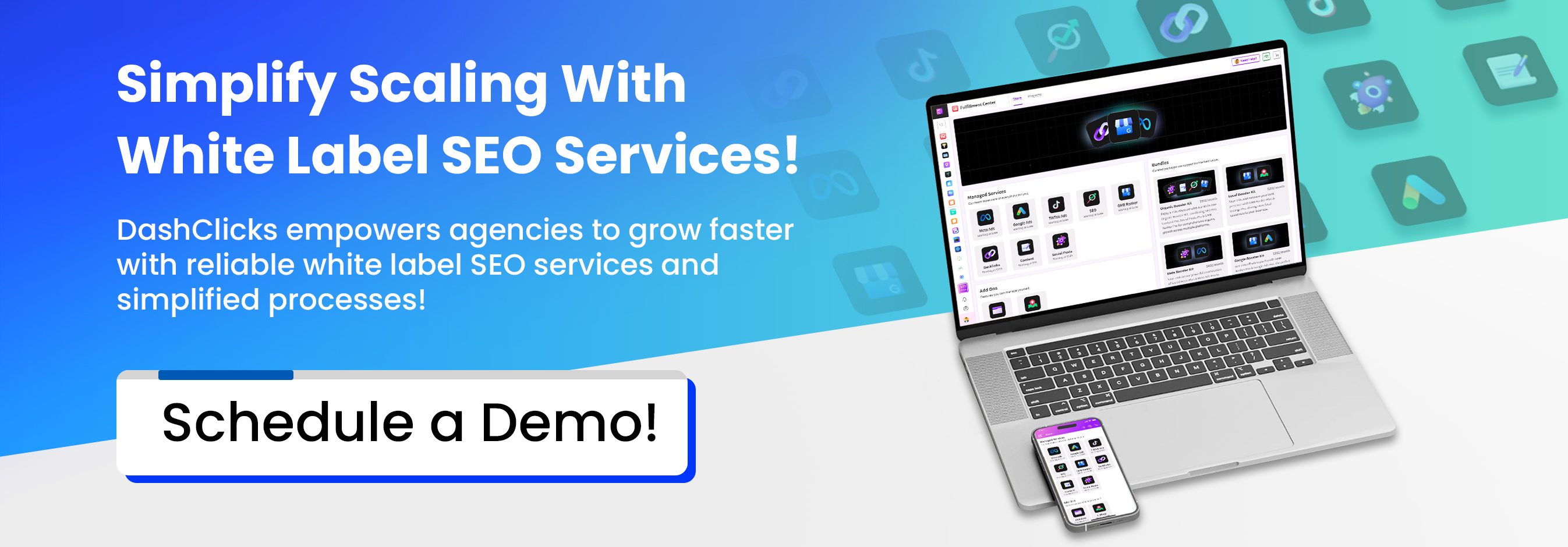
.jpg)
Integrating White Label SEO into Multi‑Service Bundles (PPC, Social, Listings)
Digital marketing agencies face a challenging reality. While 70% of agencies offer SEO services, many struggle with in-house delivery complexity and resource constraints. The competitive advantage now belongs to agencies that can provide comprehensive digital marketing packages combining SEO, PPC, social media, and local listings under one roof.
The solution lies in white label SEO integration—a strategic approach that solves the expertise gap while maintaining client relationships and brand control. This method offers significant benefits: cost efficiency, enhanced scalability, and improved client retention through bundled service offerings.
As businesses increasingly demand integrated marketing solutions, agencies that master multi-service bundles position themselves for sustained growth and competitive differentiation.
Why Bundle White Label SEO Services?
The Multi-Service Bundle Advantage
Multi-service bundling isn’t just about convenience—it’s about building a digital ecosystem where each service strengthens the other. Instead of selling SEO, PPC, social, or listings separately, agencies offer them as a unified growth engine.
Bundling white label SEO with complementary services creates a powerful value proposition. Rather than offering standalone SEO services, successful agencies combine it with PPC advertising, social media management, and local listings management to create comprehensive digital marketing ecosystems.
Why It’s Smarter Than Single-Service Offers?
Single-service agencies often hit a wall. SEO alone takes time to show results. PPC alone can be expensive without organic reinforcement. Social media alone can build awareness, but not always conversions.
Bundling provides:
- Higher Client Value – Every channel supports the other.
- Reduced Churn – Clients are less likely to switch providers.
- Easier Upselling – Add-ons feel natural within a package.
Clients receive unified strategies where each service reinforces the others, leading to better overall results and higher perceived value.
Core White Label SEO Components
A typical white label SEO package includes:
- Keyword Research and Competitive Analysis
- Technical Website Audits and Optimization
- Content Creation and Optimization
- Link Building and Outreach Campaigns
- Performance Tracking and Reporting
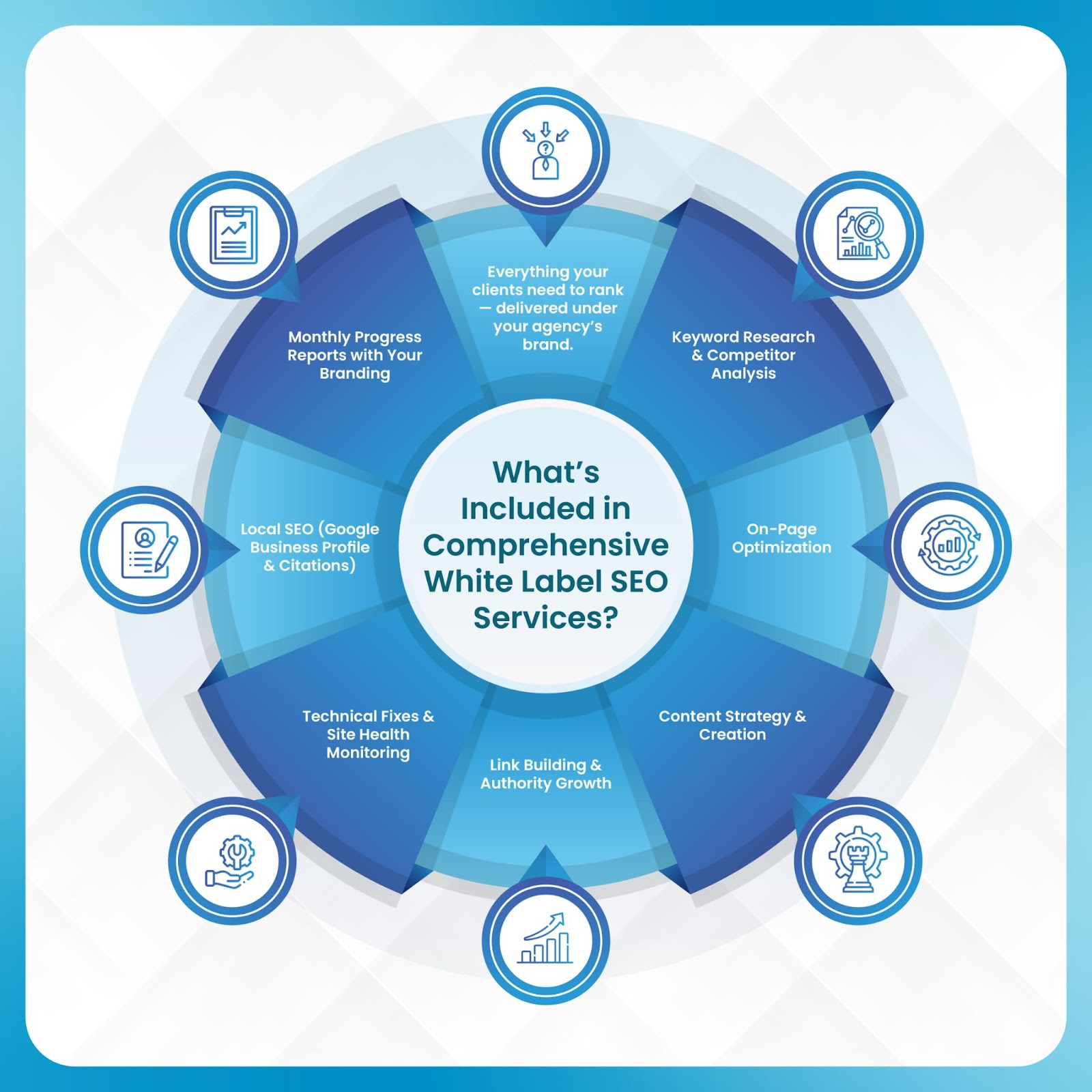
These elements go far beyond just ranking websites—they provide insights that improve paid ads, social campaigns, and local visibility.
Cross-Channel Optimization Benefits
White label SEO services provides valuable insights that enhance other marketing channels. Keyword research informs PPC ad targeting and social media content strategies. SEO content structure guidelines improve landing page design for paid campaigns. Location-based keywords from local SEO efforts enhance social media posts for businesses with physical locations.
For example, an e-commerce client's SEO keyword research revealing high search volume for "sustainable fashion" can inform their social media content calendar and PPC ad copy, creating consistent messaging across all channels.
The Power of Bundles: One Contract, Multiple Growth Engines
From the Client’s Perspective:
- Cost Efficiency – One bundled contract instead of multiple vendors.
- Unified Strategy – A single team aligning SEO, PPC, and social for consistent messaging.
- Simplified Reporting – One dashboard, one point of contact, one clear ROI story.
According to recent industry data, clients using bundled services typically see 35% better ROI compared to those using separate service providers for each marketing channel. This improvement stems from the strategic alignment between different marketing activities.
From the Agency’s Perspective:
- Higher Margins – Bundling reduces delivery costs per service.
- Improved Retention – Clients with multiple services are harder to lose.
- Upsell Opportunities – Easier to grow accounts when the foundation is already bundled.
Clients become more invested in the relationship when multiple services are involved, making it harder for competitors to win their business. The overhead costs of client management, reporting, and communication are spread across multiple services, increasing overall profitability per client relationship.
Think of it as giving clients multiple growth engines under one hood—SEO, PPC, social, and listings all firing together.
Digital Ecosystem Approach
The most successful agencies position bundles as integrated "digital ecosystems" rather than collections of separate services. This positioning helps clients understand how SEO, PPC, social media, and listings work together to achieve their business goals.
Popular bundle combinations include:
- Essential Package: SEO + Local Listings Management
- Growth Package: SEO + PPC + Social Media Management
- Premium Package: Comprehensive bundle with website design, SEO, PPC, social media, and reputation management
The Strategic Benefits of Integration
1. Cost Savings and Resource Optimization
Hiring in-house SEO specialists costs agencies an average of $75,000-$120,000 annually per expert, plus benefits and training expenses. White label SEO partnerships typically cost 40-60% less while providing access to entire teams of specialists.
Bundling further reduces per-service delivery costs, shared client onboarding, unified reporting systems, and consolidated communication protocols.
This cost difference allows agencies to allocate resources more effectively. Internal teams focus on client acquisition, relationship management, and strategic planning while white label SEO partner handle technical execution.
2. Access to Specialized Expertise
SEO isn’t static. Between core Google updates, schema changes, AI-driven search, and technical ranking factors, it’s nearly impossible for small teams to stay updated.
White label SEO providers give you:
- Dedicated SEO experts who live and breathe updates.
- Access to advanced tools for audits, keyword tracking, and link building.
- Comprehensive strategies that many agencies can’t build in-house.
This closes the expertise gap and ensures clients see you as a trusted authority.
3. Enhanced Scalability
As your agency grows, bottlenecks often appear: hiring delays, workload imbalances, and limited bandwidth. A white label SEO agency solves this by giving you on-demand scalability.
- Take on more clients without hiring instantly.
- Adjust services up or down as client demand changes.
- Handle larger accounts without stressing your internal team.
Agencies can confidently take on additional clients knowing their fulfillment partner can handle increased capacity demands. Your growth potential becomes virtually limitless. This scalability proves especially valuable during growth periods or when landing large enterprise clients with extensive SEO requirements.
Multi-Service Bundle Synergies
1. SEO + PPC Integration Benefits
The combination of SEO and PPC creates powerful synergies.
- Shared keyword data = smarter campaigns across both organic and paid.
- SEO insights improve ad targeting and landing page design.
- PPC testing feeds back into SEO strategy—helping refine headlines, CTAs, and content focus.
A unified search strategy typically delivers 25% higher conversion rates compared to running SEO and PPC campaigns in isolation. The combined approach also provides valuable testing opportunities—PPC campaigns can quickly test new keywords and landing pages before committing to long-term SEO investments.
2. Social Media and SEO Alignment
Social media drives awareness, SEO drives intent. When aligned:
- Social signals boost SEO authority and local rankings.
- Blog posts and SEO content can be repurposed for social campaigns.
- Cross-channel strategies ensure consistency in voice, branding, and reach.
Optimizing both your website content and social media presence creates a flywheel effect that drives discovery and engagement.
Local businesses particularly benefit from this integration. Google Business Profile optimization techniques align with social media profile optimization, creating consistent NAP (Name, Address, Phone) information across all platforms.
3. Local Listings and SEO Synergy
For multi-location businesses, local SEO and listings are inseparable.
- Accurate citations improve Google Map Pack visibility.
- NAP consistency (Name, Address, Phone) builds local trust signals.
- Reviews and citation management strengthen both reputation and search rankings.
When listings management is handled alongside SEO, agencies deliver better local visibility and stronger organic performance. White label SEO providers can manage local SEO + listings seamlessly, especially for multi-location businesses.
White label providers like DashClicks can manage local SEO + listings seamlessly, with their white label listing management services, especially for multi-location businesses.

Implementation Strategies and Best Practices
1. Choosing the Right White Label SEO Partner
Successful integration requires careful partner selection. Key evaluation criteria include:
- Transparent reporting capabilities and white-labeled deliverables.
- Proven track record with ethical SEO best practices.
- Scalable service delivery to accommodate growth.
- Clear communication protocols and quality control measures.
Request case studies, client references, and examples of reporting formats before making partnership decisions.
2. Service Package Development
Create tiered offerings that appeal to different client segments and budgets:
- Essential Tier: Basic SEO + local listings management for small businesses.
- Growth Tier: SEO + PPC + social media management for expanding companies.
- Premium Tier: Comprehensive packages including website design, SEO, PPC, social media, and reputation management for agencies.
Price bundles to provide clear value compared to individual service pricing while maintaining healthy profit margins. Pricing strategies your agency should consider:
- Bundle for value, not just discounts.
- Show cross-channel ROI during proposals.
- Emphasize how services amplify one another.
Onboarding should be seamless, with centralized dashboards and clear timelines.
3. Managing Client Expectations
Set realistic timelines from the start. SEO results typically require 4-6 months to show significant progress, while PPC campaigns can deliver immediate visibility. Explain how each service reinforces others for better overall performance. Think about it—if results don’t match what a client was led to believe, frustration builds quickly. To put it in perspective, here’s a breakdown of why clients often decide to end agency partnerships.
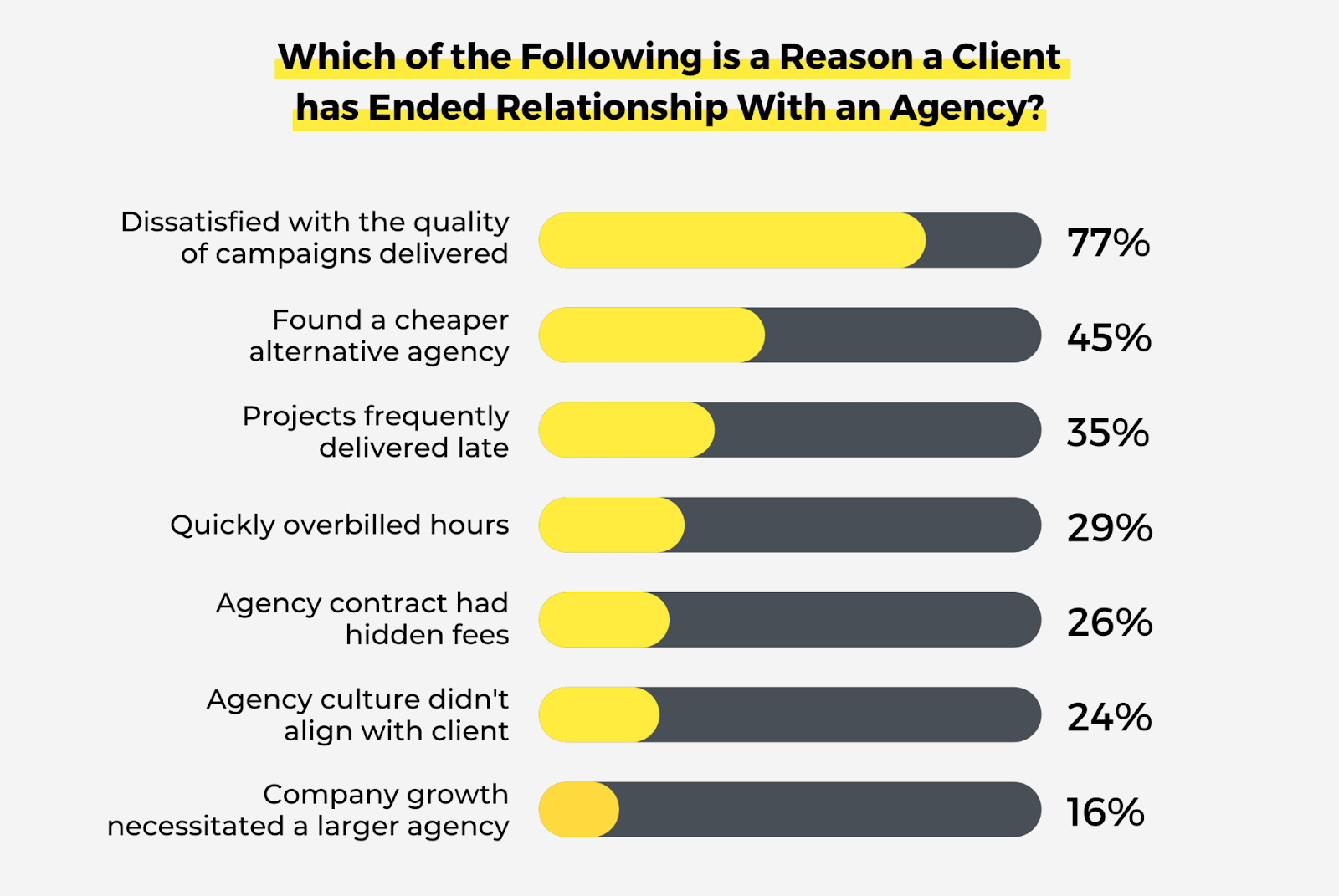
Use shared dashboards and cross-channel reporting to demonstrate the integrated value of bundled services. Clients should clearly see how SEO improvements support PPC performance and vice versa. When clients understand how SEO, PPC, and social work together, retention rates soar.
Further Reading: Managing Client Expectations in Digital Marketing Campaigns
Common Integration Challenges and Solutions
1. Maintaining Quality Control
Quality concerns often arise when working with external partners. Biggest concerns include:
- Consistency across providers.
- Service overlap or redundancy.
- Risk of overpromising results.
Address these through:
- Regular audit processes and performance reviews.
- Established client feedback systems.
- Clear service level agreements with measurable metrics.
- Regular communication between the agency and white label teams.
2. Pricing and Margin Management
Common Pitfalls:
- Underpricing bundles just to close deals.
- Not accounting for partner costs in margin calculations.
- Lack of transparency with clients.
Develop transparent cost structures that account for:
- White label service fees.
- Internal overhead and management time.
- Profit margins that remain competitive while ensuring sustainability.
Avoid common pricing mistakes like underestimating the time required for client communication and project coordination.
3. Service Overlap Management
Prevent confusion by clearly defining which partner handles specific aspects of integrated campaigns. Create detailed workflow documentation outlining responsibilities, communication protocols, and escalation procedures.
How DashClicks Enables White Label SEO Integration for Agencies?
DashClicks provides a comprehensive platform for agencies looking to integrate white label SEO services into multi-service bundles seamlessly. Their all-in-one solution combines powerful software tools with white-labeled fulfillment services, enabling agencies to offer complete digital marketing ecosystems without the complexity of managing multiple vendors.
The platform's strength lies in its integrated approach to service delivery. Agencies can manage SEO campaigns alongside PPC advertising, social media management, and local listings through a unified dashboard. This integration ensures consistent reporting, streamlined communication, and coordinated strategy implementation across all services.
DashClicks' white label SEO services include comprehensive keyword research, technical audits, content optimization, and link building—all delivered under the agency's brand. The platform's reputation management tools complement SEO efforts by monitoring and improving online reviews, which directly impact local search rankings.
Their InstaSites software enables rapid website deployment optimized for SEO, while the analytics dashboard provides real-time performance tracking across all marketing channels.
Transform Your Agency Into a Growth Partner
Strategic white label SEO integration within multi-service bundles represents more than operational efficiency—it's your pathway to market leadership. Agencies that master this approach achieve 40% higher client retention, 67% increased lifetime value, and sustainable competitive advantages.
The transformation from service provider to growth partner happens when you deliver measurable business results across multiple channels rather than isolated tactical improvements. Your clients gain a unified marketing strategy that amplifies performance across every digital touchpoint.
Immediate Action Steps:
- Audit your current service gaps and identify the highest-value integration opportunities.
- Research and evaluate white label SEO providers that align with your quality standards and growth plans.
- Develop three-tier bundled service packages that address different client needs and budget ranges.
- Create client communication templates that clearly articulate bundle value and service integration benefits.
The digital marketing landscape rewards agencies that provide comprehensive solutions. White label SEO bundling gives you the expertise, scalability, and competitive positioning to capture this opportunity without the overhead and complexity of building everything in-house.
Your next client conversation can shift from discussing individual services to presenting a complete growth strategy. That's the difference between being a vendor and becoming an indispensable business partner.
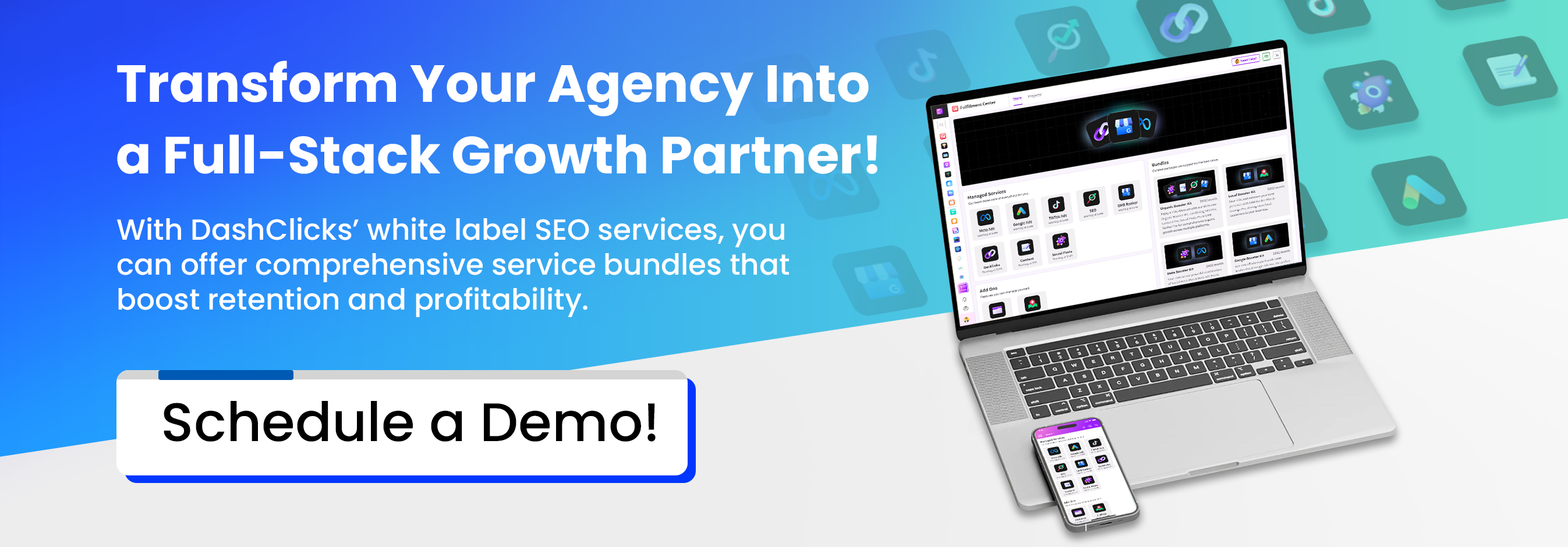

No results found.
Please try different keywords.
Get Started with
DashClicks Today
Get found online, convert leads faster, generate more revenue, and improve your reputation with our all-in-one platform.
.svg)
Unlimited Sub-Accounts
.svg)
Unlimited Users
.svg)
All Apps
.svg)
All Features
.svg)
White-Labeled
.svg)
Active Community
.svg)
Mobile App
.svg)
Live Support
.svg)
100+ Tutorials
.svg)
Unlimited Sub-Accounts
.svg)
Unlimited Users
.svg)
All Apps
.svg)
All Features
.svg)
White-Labeled
.svg)
Active Community
.svg)
Mobile App
.svg)
Live Support
.svg)
100+ Tutorials
.svg)
Unlimited Sub-Accounts
.svg)
Unlimited Users
.svg)
All Apps
.svg)
All Features
.svg)
White-Labeled
.svg)
Active Community
.svg)
Mobile App
.svg)
Live Support
.svg)
100+ Tutorials



.svg)
.svg)
.svg)
.svg)
.svg)


